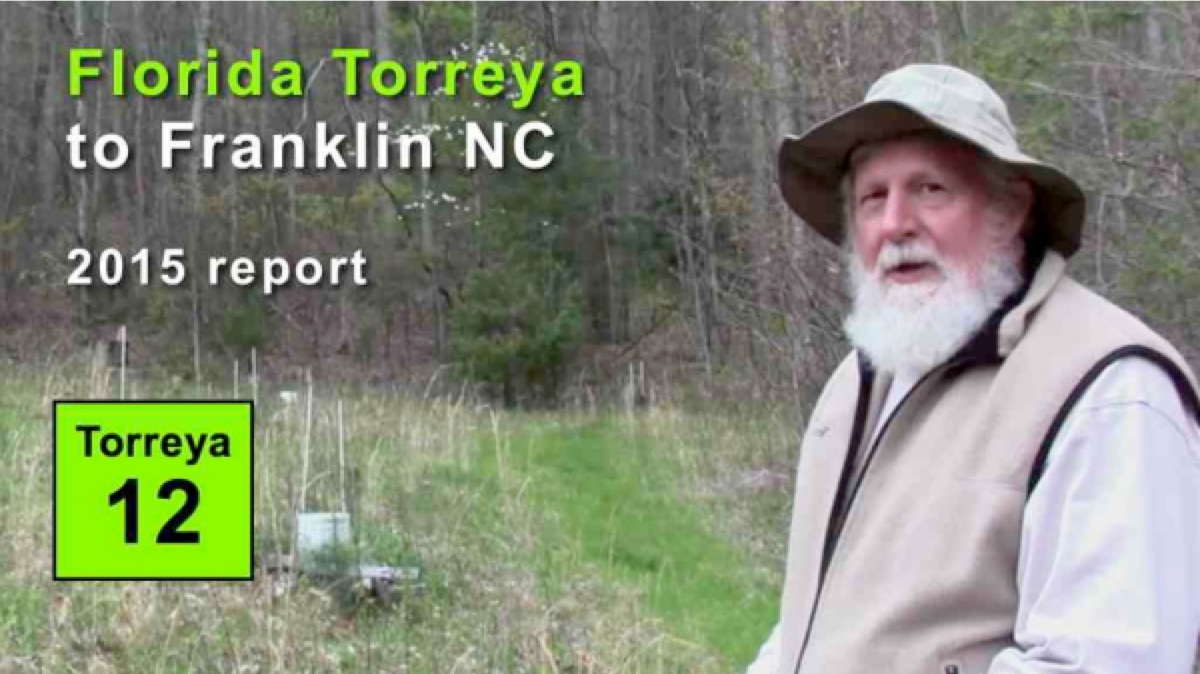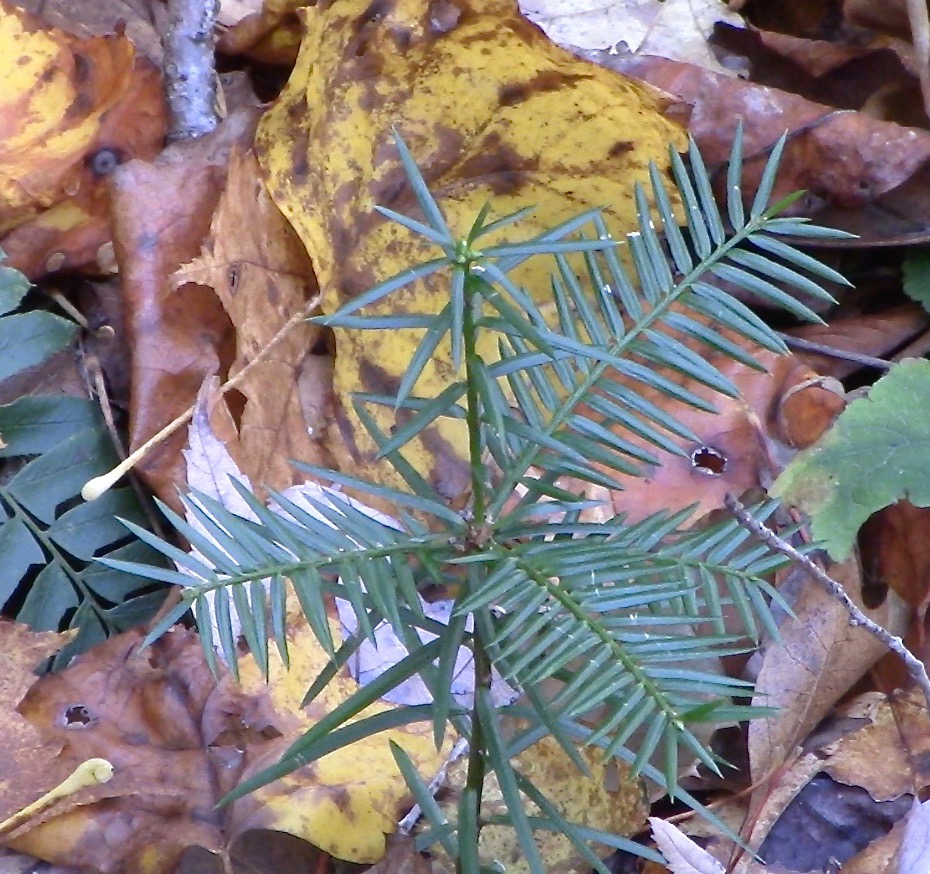 |
Free-Planting Seeds Directly into Forest 3,800 feet elevation, remote western North Carolina
West Slope of Blackrock Mountain Home of RUSSELL REGNERY (Cold Mountain Rd)
April 2015 and November 2018 site visits
|
2015 BACKGROUND:
• VIDEO 12: FL Torreya to Franklin, NC: 2015 Report
Russ's site is the highest elevation of the THREE 2008 PLANTINGS (3,800 feet) and the only locale where most of the specimens were not only planted in full sun but also maintained in full sun through the years.
At the April 2015 visit, Connie donated to Russ 50 SEEDS from the 2014 fall harvest — 15 of which she filmed Russ planting in his forest ("free-planting"), with no rodent protection.
The seed-planting action is documented in the video above. Also, visit the WEBPAGE for this Torreya site. (A video of the 2018 site visit will be posted when available.)
2018 BACKGROUND:
FOUR GROWING SEASONS AFTER 15 SEEDS WERE FREE-PLANTED, Connie Barlow returned to (a) document the progress of the 2008 plantings of potted seedlings and (b) scout for and document any seedling successes from the free-planted seeds. This site visit was 7 NOVEMBER 2018.
UNPROTECTED, FREE-PLANTED SEEDS bear these risks:
2. SEED PREDATION by squirrels or tunneling rodents (rodents can smell the seeds)
3. LEAF HERBIVORY post germination (needle-sharp leaves are a deterence after hardening)
4. DEER ANTLER RUBBING when the seedlings reach 2 or 3 feet tall
Note: Russ reports, "Deer are uncommon in our area; however, one deer of course can do a lot of damage in a short space of time. We do have rabbits and woodchucks. I don't know if a turkey (which are regulars) might crop the top of a relatively tender seedling?
2018 RESULTS / INTERPRETATIONS - Photos of 6 TOTAL SEEDLINGS are at bottom.
1. CREEK ISLAND SITE - 2 seedlings documented of 3 seeds planted (see photos below)
But then it was cropped off almost to the ground by an herbivore.
Then the seed put forth a replacement stem during its fourth growing season after free-planting.
Connie has documented this remarkable seed ability once before. See PHOTOS BELOW.
PHOTOS BELOW: Documention of an inadvertently useful free-planting experiment by Connie:
ABOVE LEFT: Autumn 2017: Connie had put the seed too far downslope under a too-huge flat rock. Emerging stems trend upward, but this one first looped the seed while under the rock (white growth is all under the rock, which Connie removed for examination). The yellow arrow points to where the initial stem (green where it emerged from the rock) had been cropped off by an herbivore. The green arrow points to the tip of a second stem attempt underway. See that it emerges at the seed, but this time it seems to have "learned" that it needs to head directly upslope. Connie replaced the rock several inches further downslope — such that the stem tip just barely emerged.
ABOVE CENTER AND RIGHT: Autumn 2018: One year later, Connie checks again and is thrilled to see that the seed had enough stored energy to grow this second attempt to completion. But see how this new growth is much shorter than usual. As soon as out from under the rock, this individual grew just enough to spread its leaves to the sun.
Because Torreya's seed is huge, indicative of subcanopy adaptation, it is demonstrably capable of growing (and regrowing) a great deal (below and above ground) before needing to access energy from sunlight.
The 3 remaining seedlings were of the 7 seeds planted in the swale in 2015 that heads downslope of the gray bench, downslope of the old road and toward the meadow fenceline.
SEEDLING 4 - The first photo shows how I marked each seedling with an orange tape ribbon on a nearby small tree branch. Because this one was planted 2 feet from a mossy boulder (and boulders are rare here), it was easy to find. Because it appears to be just one season of growth, although with a strange 3-leaflet topknot, the best supported conclusion is that it appeared above ground only during the 4th summer. If this is true, the LESSON FOR ALL TORREYA PLANTERS is to wait at least 5 years before you assume a planted seed is a dud or predated.
SEEDLING 5 - My notes for finding it were sparse: "open, small stems around, baby maple". Well, that "baby maple" had grown tall 4 summers later! It is shown in the first of the three-photo set, still bearing its autumn-yellow leaves. The remaining two photos indicate that this is yet another example of a seedling that waited 3 full summers before showing above ground. Unlike Seedling 4, this one has a normal top: 2 lateral buds ready to grow Spring 2019. Typically, the first lateral growth is just 1 or 2 buds after the initial vertical stem.
SEEDLING 6 - This seedling is worthy of contemplation! View all photos to see that (a) this is the only seedling with a true basal, and (b) this seedling endured one or two instances of herbivore cropping of the most important section: apical growth of the leader. Yet look at how it recovered! It is possible that the first nipping of the apex is what induced the basal growth. Yet volunteers have also documented new leaders attempting to grow right from the vertical stem, just below the nipped-off section.
DETAILS ON THE 6 SEEDLINGS
• SEEDLING 1 - CREEK ISLAND
The 2 "Creek" seeds are planted 8 feet apart in the open brown area 1/4th up from the bottom of photo below and horizontally in the center (just to the right of the massive old Rhododendron grove.
The key marker onsite is an 8-inch DBH Robinia trunk — a genus that, as with the nearby Liriodendron and Maple trees, attracts the same mycorrhizal fungi type class as Torreya does.
This 7 November 2018 photo shows the trunks of a deciduous forest that has largely lost its leaves.
Late autumn is thus the onset of maximal opportunities for evergreen Torreya to photosynthesize (possibly in the winter, too, and certainly again in early spring).
As well, three lateral buds at the apex (photos below) are poised to open Spring 2019.
Note: Torreya Guardians volunteers have discovered that, in favorable conditions, there seems to be two growth spurts per year (spring and late summer) for torreyas, especially after their first few years.
ABOVE SEEDLING 1 is in the exact center of the photo.
BELOW: View directly up from SEEDLING 1 (7 November 2018).
• SEEDLING 2 - CREEK ISLAND
ABOVE & BELOW: SEEDLING 2 is near-center of photos (by black soil where leaves cleared away).
ABOVE LEFT: The single vertical stem of SEEDLING 2 with radiating leaves has the typical form of the first growth spurt. Notice the half-size upright leaves at the apex; this is not a usual feature. Was this a second, minor spurt of growth? As well, notice the good amount of sunlight reaching its leaves (left and top photos). How does good lighting under a seasonally leaf-free (deciduous) forest affect the growth pattern?
ABOVE RIGHT: Only the apex bud looks ready for Spring 2019 growth. Will a second vertical spurt happen before a first lateral branch?
ABOVE LEFT: Look carefully at the base of SEEDLING 2. It appears that an initial stem grew but was cropped off by an herbivore. Then the seed grew a replacement stem.
ABOVE RIGHT: The seed of genus Torreya is huge, indicative of subcanopy adaptation. It is capable of growing a great deal below and above ground before needing to access energy from sunlight.
• SEEDLING 3 - FOREST
ABOVE: April 2015 Russ Regnery plants a seed beneath a double-stem liriodendron.
BELOW: November 2018 Michael Dowd shows the result: SEEDLING 3.
ABOVE: The yewlike patterning of the leaves on SEEDLING 3 maximizes subcanopy light capture.
BELOW: Leaves harden and develop a glossy, protective surface that supports evergreen leaf longevity of 5 to 7 years. Three growth spurts are evident on SEEDLING 3 (vertical, then 2 lateral branches, then vertical again). Three buds are at the apex, ready to produce a second whorl of branches, this time with 3 branches rather than the original two.
• SEEDLING 4 - FOREST
ABOVE: Orange survey tape hangs from a sapling near SEEDLING 4. Boulder outcrops are rare in this forest, but they make excellent markers for planting sites. Behind the rock is a large Liriodendron, which seems to be the dominant canopy tree in this section of forest.
Because all vertical growth spurts emerge with leaves in an apical tuft that finally spread out when the stem reaches its maximal height, a question arises: Might an apical leaf tuft signify an early halt to further upward stem growth? Might such a halt signify that existing light capture is adequate, and that energy is redirected into more root growth? Or might a tuft signify that the entire vertical stem emerged in late summer — and cold or seasonal light shift alerted the seedling that it ought to play it safe: harden up all leaves just as they are in preparation for the winter.
• SEEDLING 5 - FOREST
ABOVE: My notes for finding SEEDLING 5 were sparse: "open, small stems around, baby maple".
SEEDLING 5 seems to be yet another example of a plant that waited 3 full summers before showing above ground. Unlike Seedling 4, this one has a normal top (un-tufted). Ready to grow Spring 2019 are 2 lateral buds. Typically, the first lateral growth is just one or two branches after the vertical stem finished its initial growth burst.
• SEEDLING 6 - FOREST
SEEDLING 6 is worthy of contemplation! It is the most difficult to interpret.
View all photos below to see that (a) this is the only seedling with a true basal, and (b) this seedling endured at least one instance of herbivore cropping (likely two) of the most important section: apical growth of the leader. Yet look at how it recovered!
ABOVE: SEEDLING 6 will produce a set of 3 lateral branches Spring 2019. Notice that, despite all its greenery, it has no lateral branching thus far. Keep reading for an interpretation as to the possible cause.
BELOW: A side view shows a strong basal growth. Key marker to find this seedling is the solitary old cedar fence post (its base is visible in photo). This fencepost is very near the forest edge; a dozen feet downslope begins the mowed meadow. The meadow is westward, and thus this seedling has access to more late afternoon sun than any of the other seedlings in the forest.
ABOVE: Looking close at the basal growth of SEEDLING 6. This is the only seedling of six that has yet produced a basal.
BELOW LEFT: Notice that the main stem shows two growth spurts vertically. This is odd because normally one or two lateral branches grow before a second vertical is produced. Also notice the color differences in the older v. the younger stem sections. New stem growth begins green, but by late the next summer it browns.
ABOVE RIGHT: A closeup look at the junction of old stem and new reveals the answer: An herbivore nipped off the apex of the old stem, thus foiling an opportunity for the seedling to grow lateral branches. Instead, the seedling put its next season growth into a new vertical stem budding off just below the injury and that veers slightly from the vertical (photo above left shows this slight angling).
CLOSE OBSERVATION in the years ahead, along with continuing pictorial documentation will offer great learnings for how best to serve this endangered species — where it is most vulnerable and in what ways it is a marvel. Thus far we can point to its patience, resilience, and adaptability — all characteristics that well serve subcanopy trees. Ideally, when this first generation of Torreya Guardians passes, there will be a new crop of volunteers to continue the long-term field studies.
1. GERMINATION FAILURE (especially if Connie's outdoor overwinter seed storage in NE Alabama was faulty)
Three seeds had been planted on an "island" where the creek (Little Buck Creek) splits. Dense rhododendrons immediately upstream of the planting area, along with the perceived dangers by deer of ravine bottoms led us to believe this site would be safe from deer herbivory. Because flowing water was on both sides, we hoped rodents would be few or absent. The two seedlings demonstrated opposite extremes of growth.
2. FOREST SITE - 4 seedlings documented of 12 seeds planted (see photos below)
SEEDLING 1 - This biggest seedling had 4 apparent growth spurts in this order: vertical, 1 lateral, 3 more laterals, vertical. As well, three lateral buds at the apex are poised to open Spring 2019. Note: Torreya Guardians volunteers have discovered that, in favorable circumstances, there seems to be two growth spurts per year (spring and late summer) for torreyas, especially after their first few years.
SEEDLING 2 - At first glance, this smallest seedling demonstrated just one growth episode. However, close examination (photo below) shows the base of the seedling, with cropped original(?) stem still green 1/2 inch to its right.
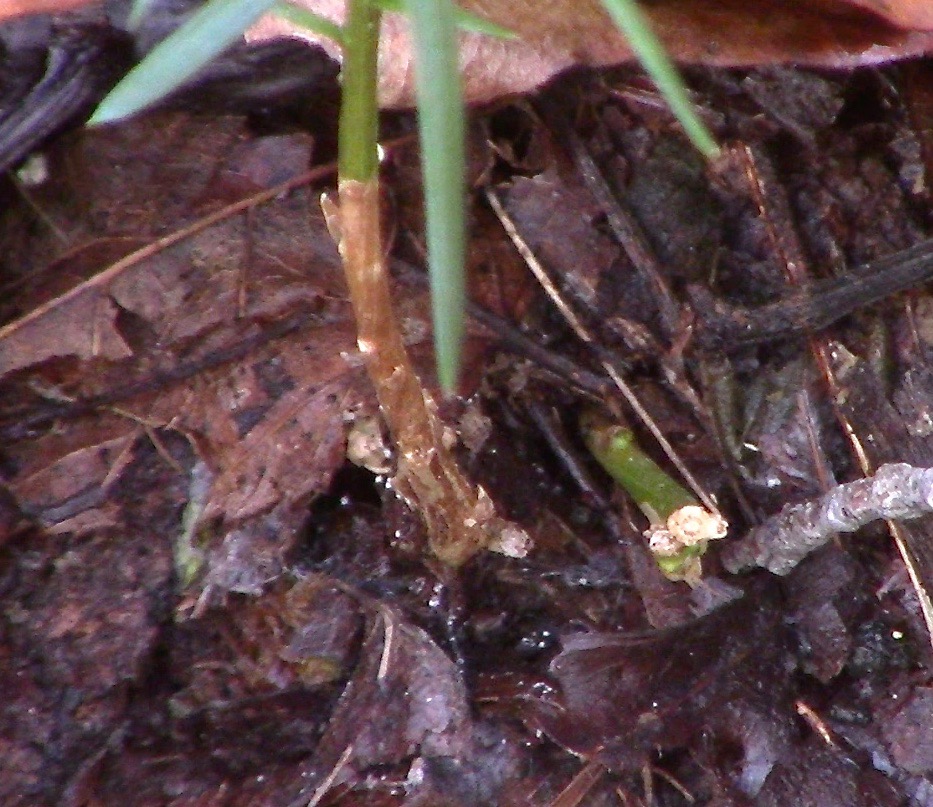
... The first growth episode thus would actually have been a prior vertical stem, with leaves radiating around it.
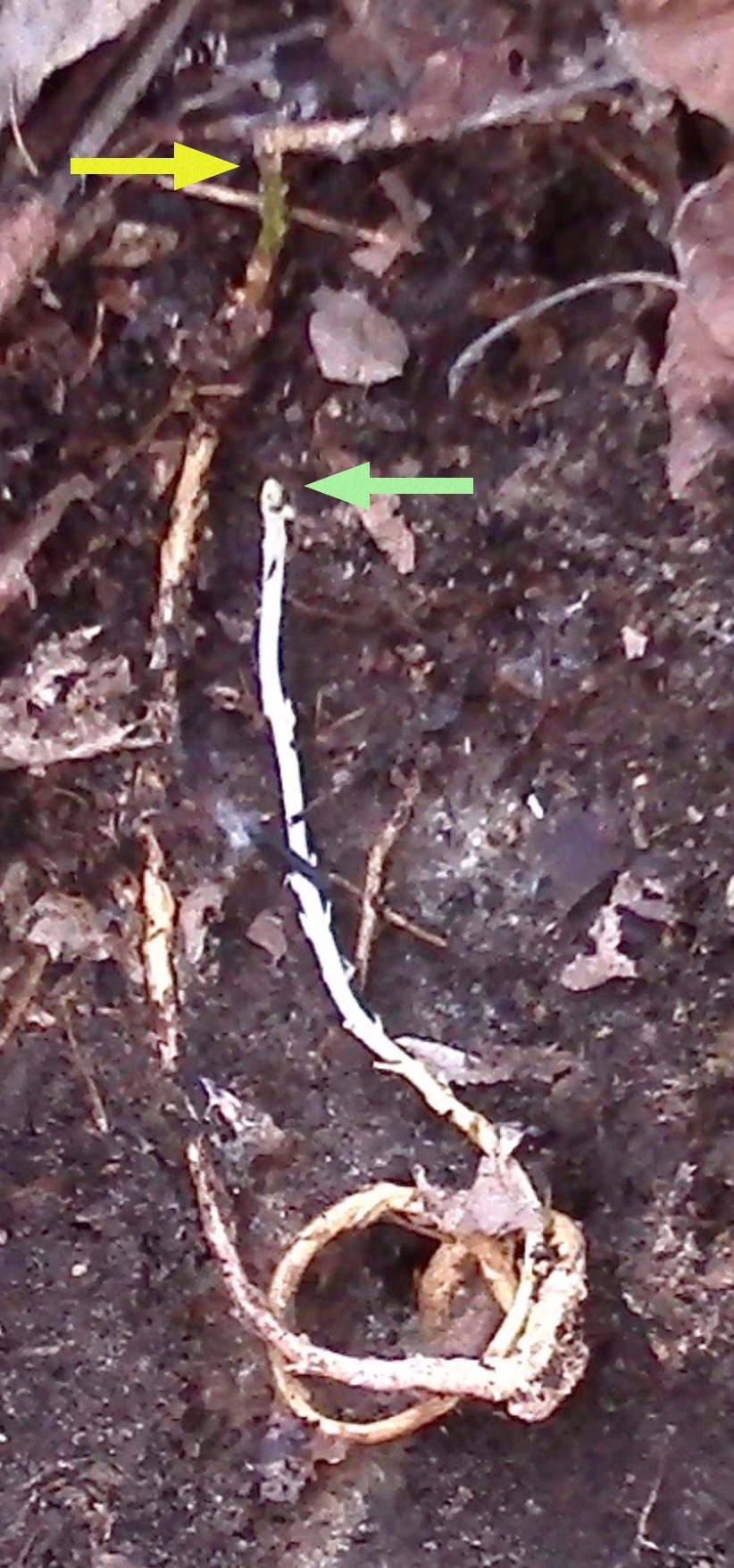
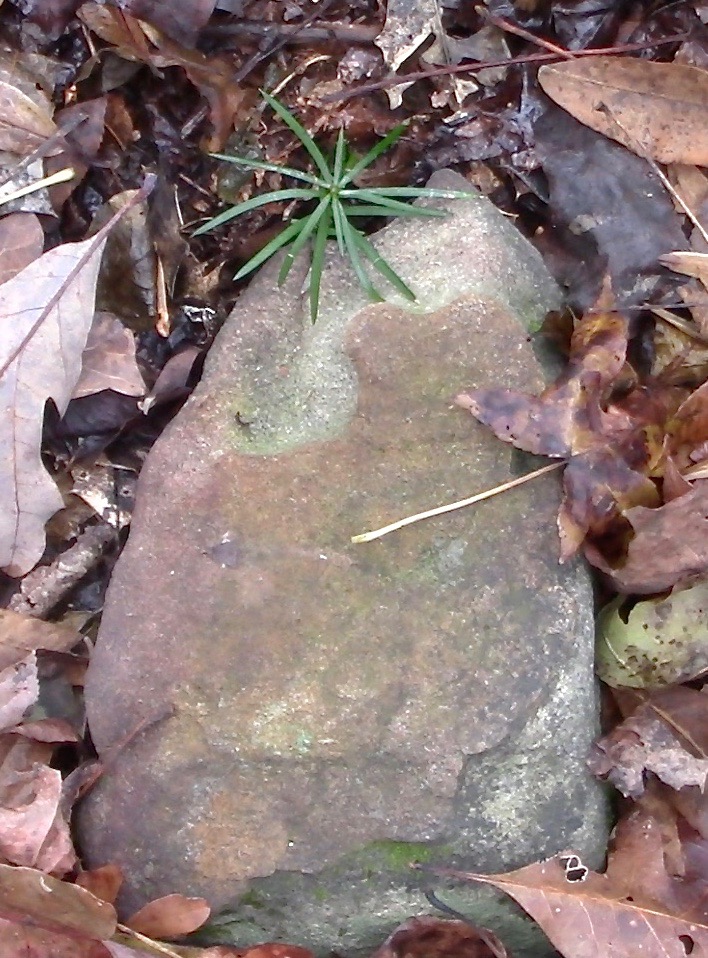
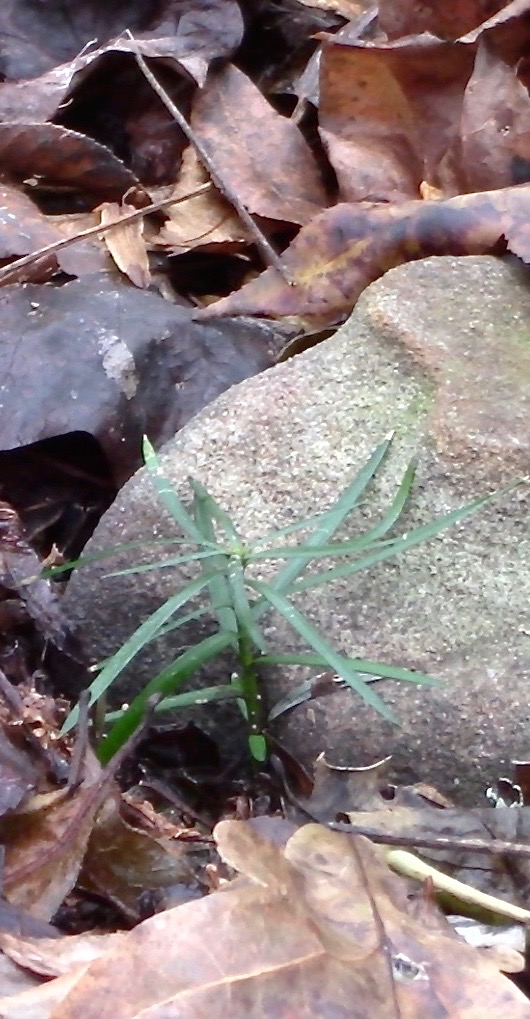
Finding a seedling at the first of twelve sites that my notes showed for the forest planting (10 ft fr double-stem lirio 18" DBH upslope 20 ft from old road, before the gray bench) was way better than winning an Easter Egg Hunt as a kid. In the first photo of SEEDLING 3 below you will see Russ Regnery planting the seed in 2015. Next is Michael Dowd showing the result in 2018. There you see how difficult these seedlings are to notice from the side, owing to their yew-like, flat leaf patterning. Top-down they are easy to spot, especially at a time of year when almost nothing else is green around them. The two lateral branches of SEEDLING 3 point west toward the meadow.
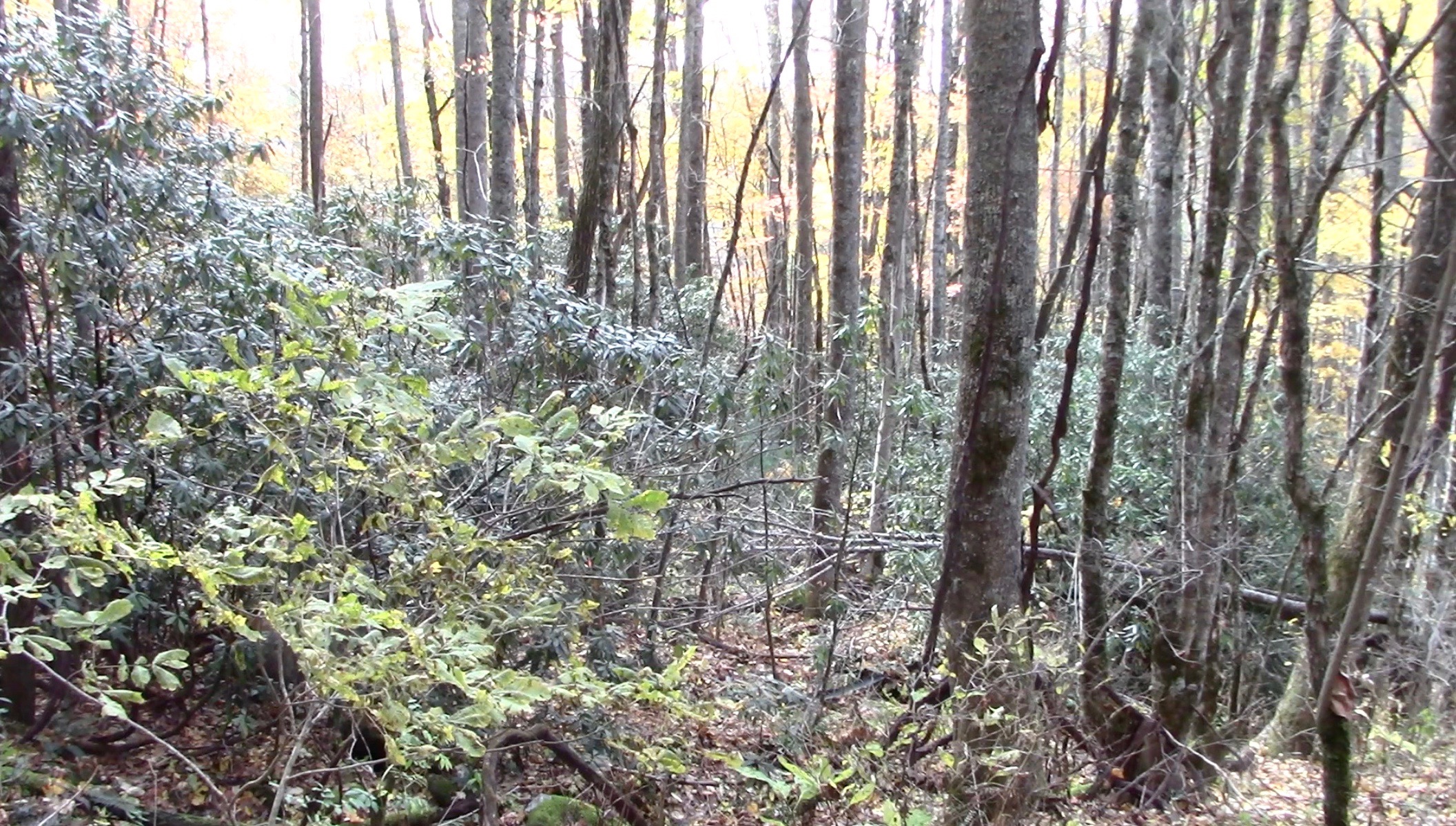
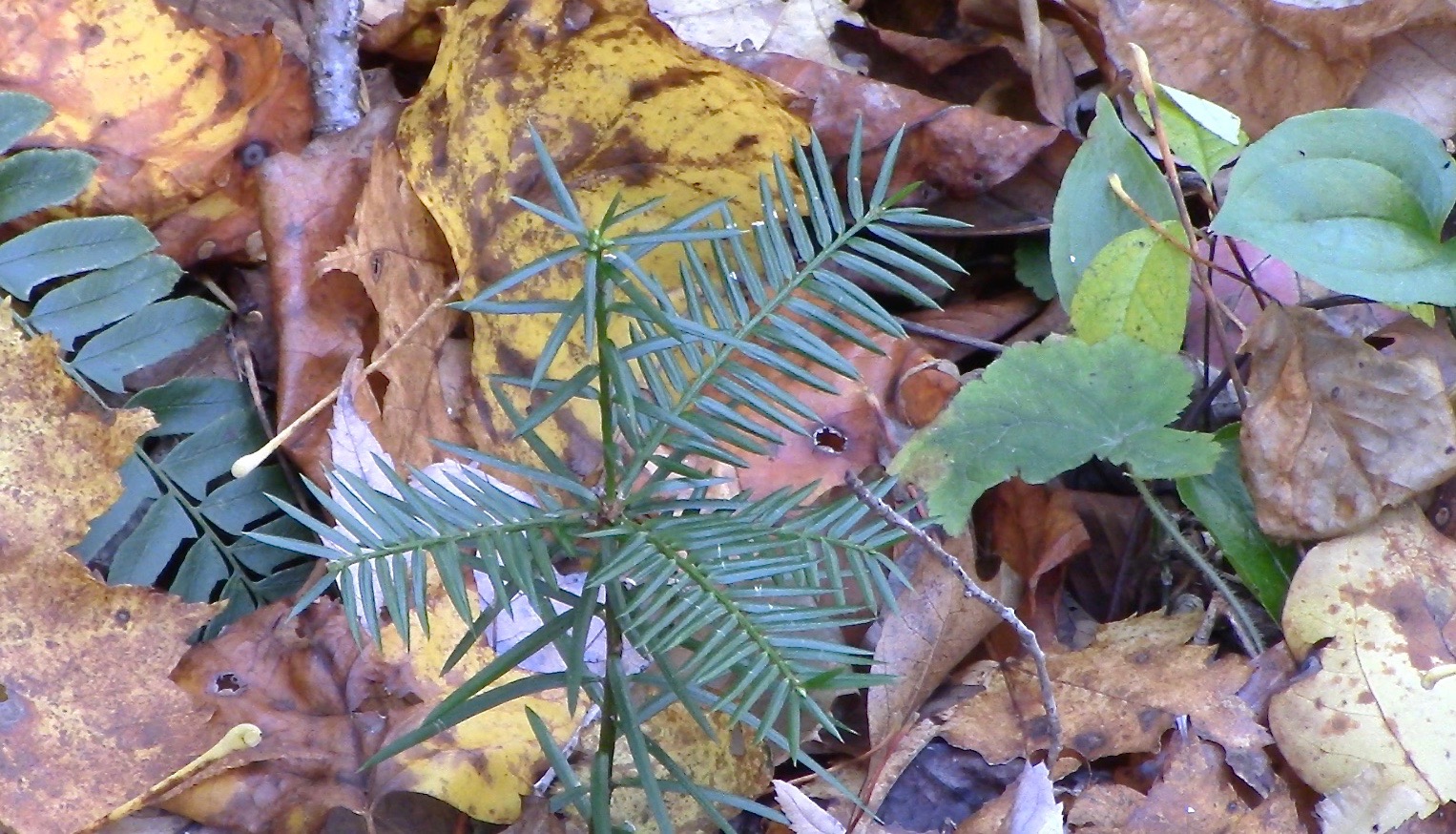
SEEDLING 1 - This biggest seedling had 4 apparent growth spurts in this order: vertical, 1 lateral, 3 more laterals, vertical.
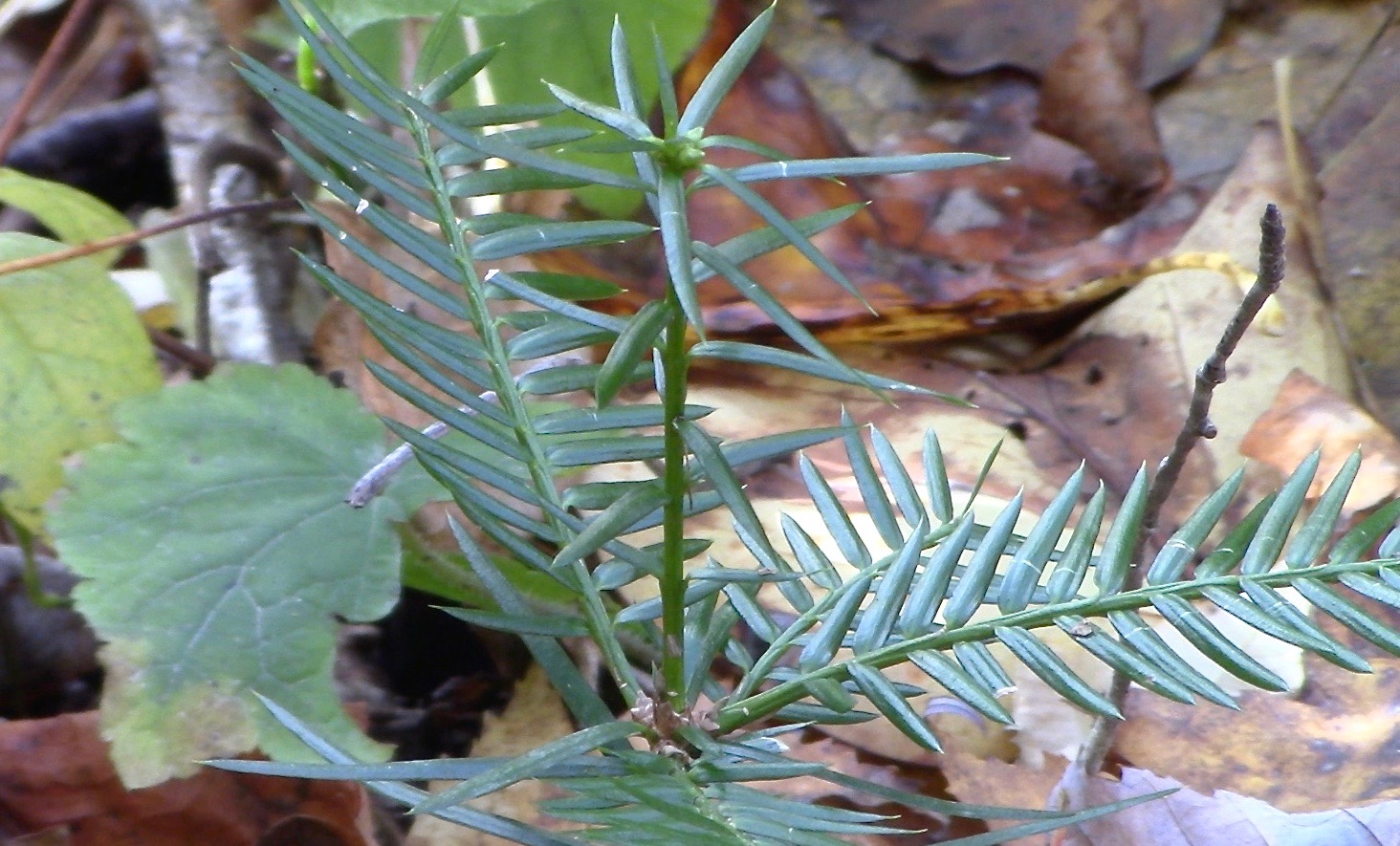
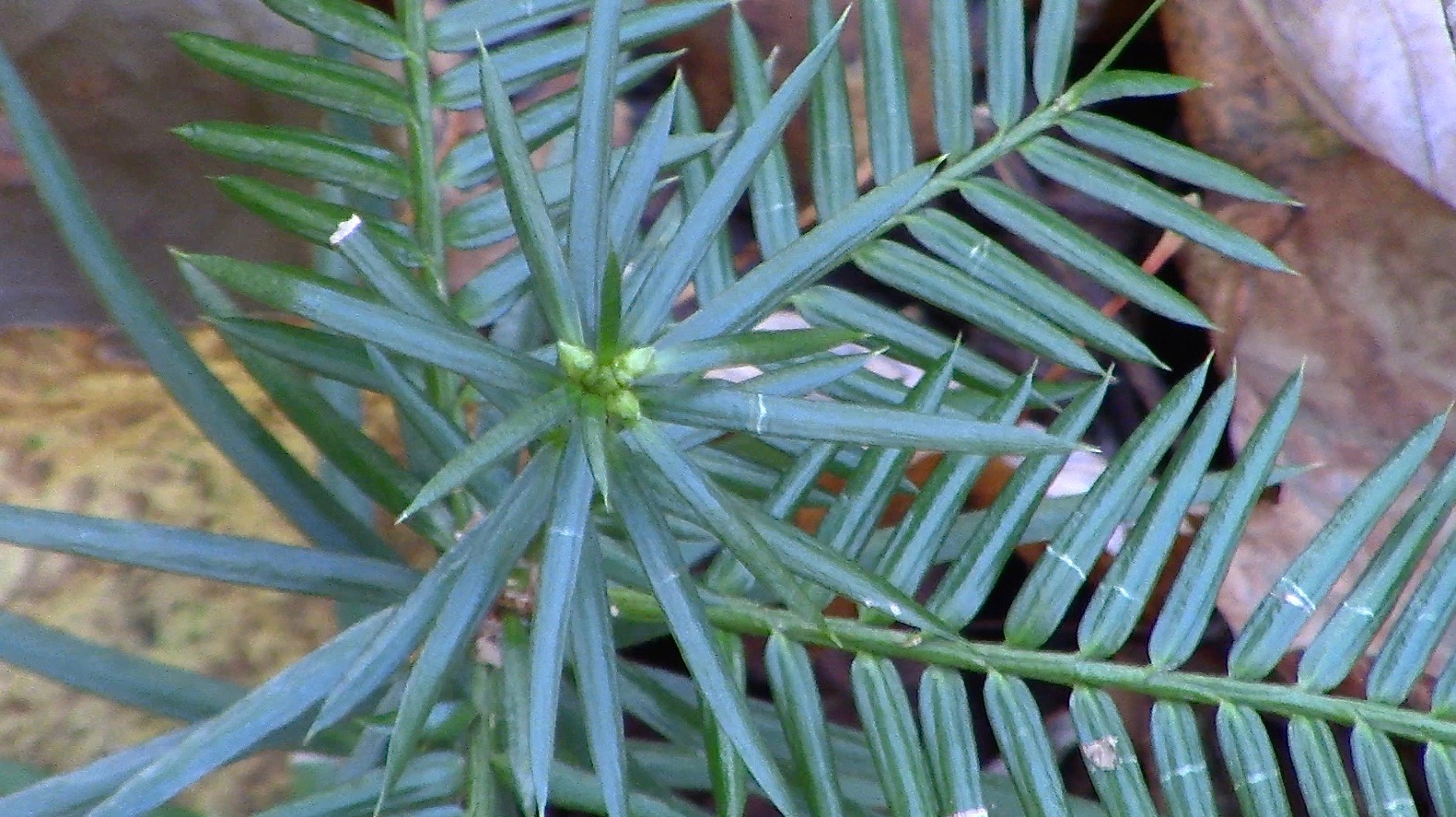
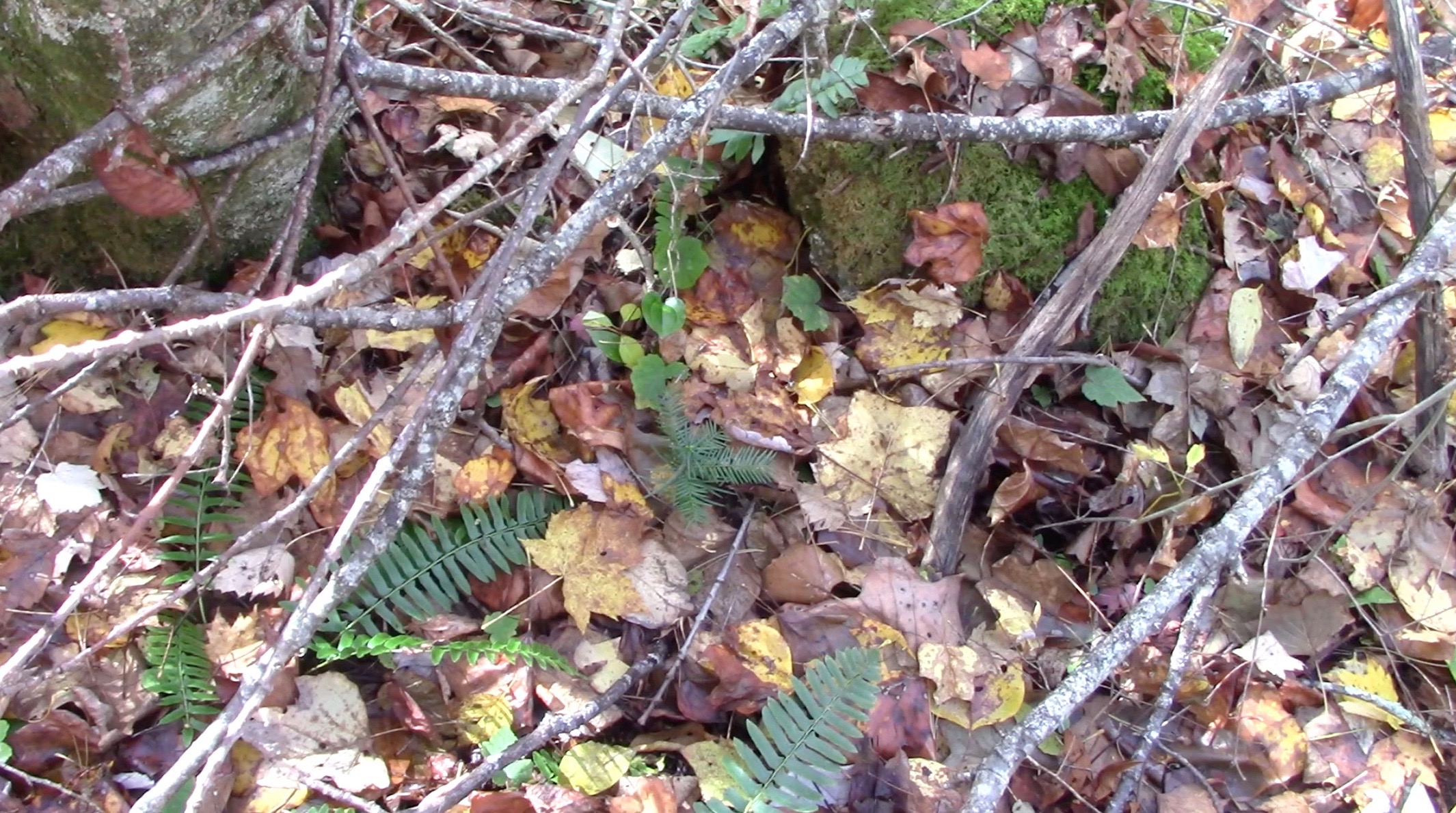
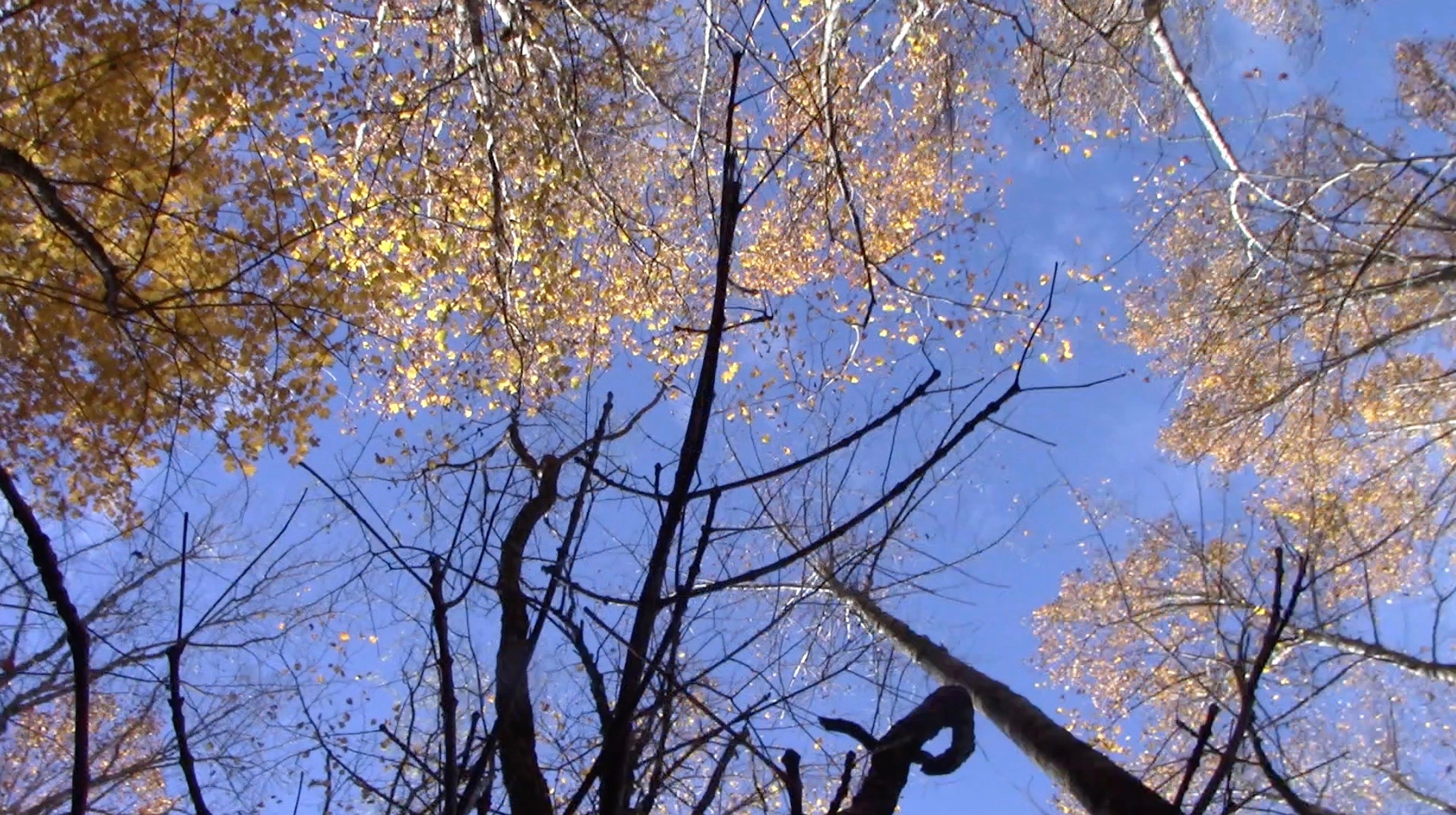
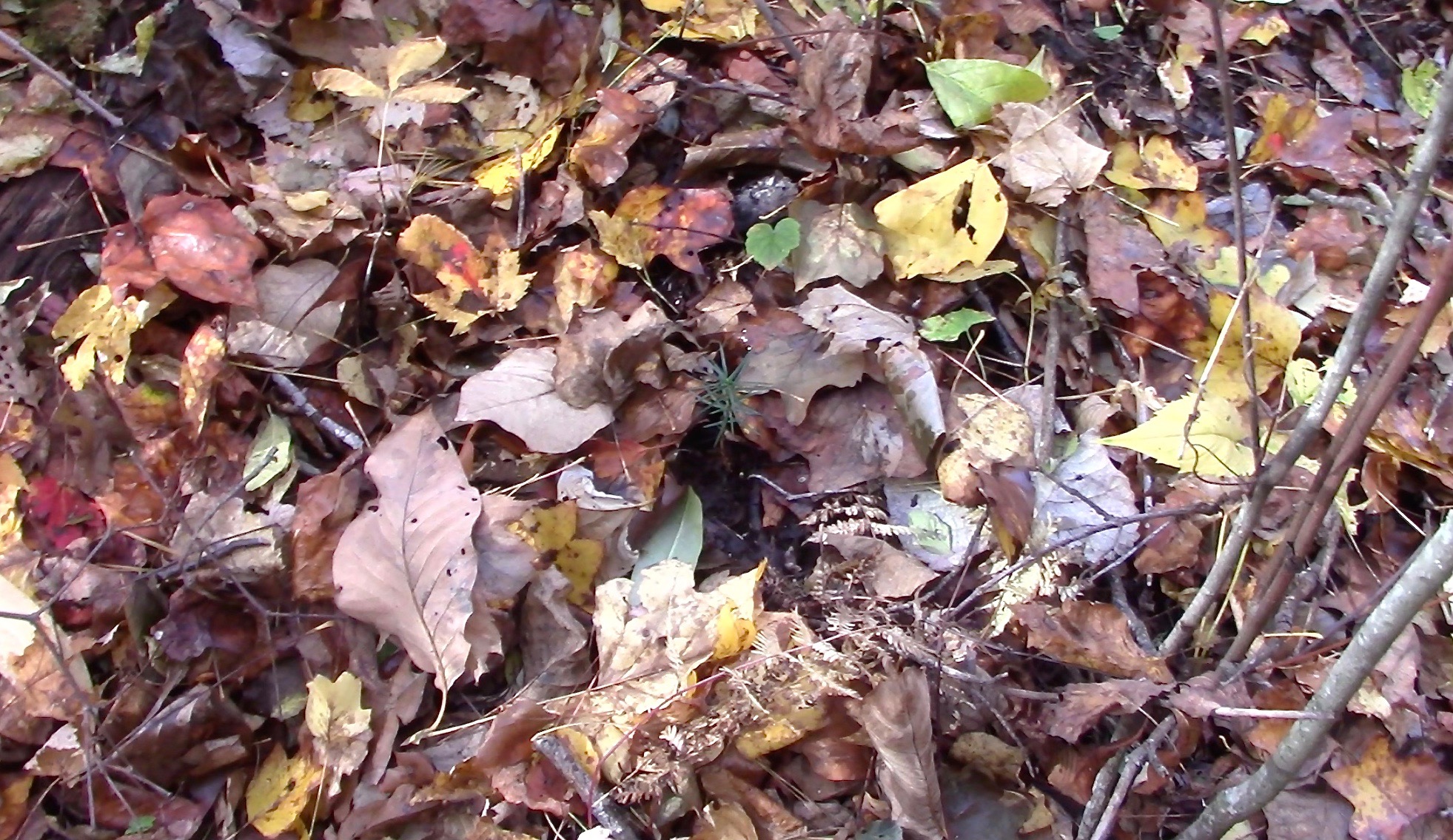
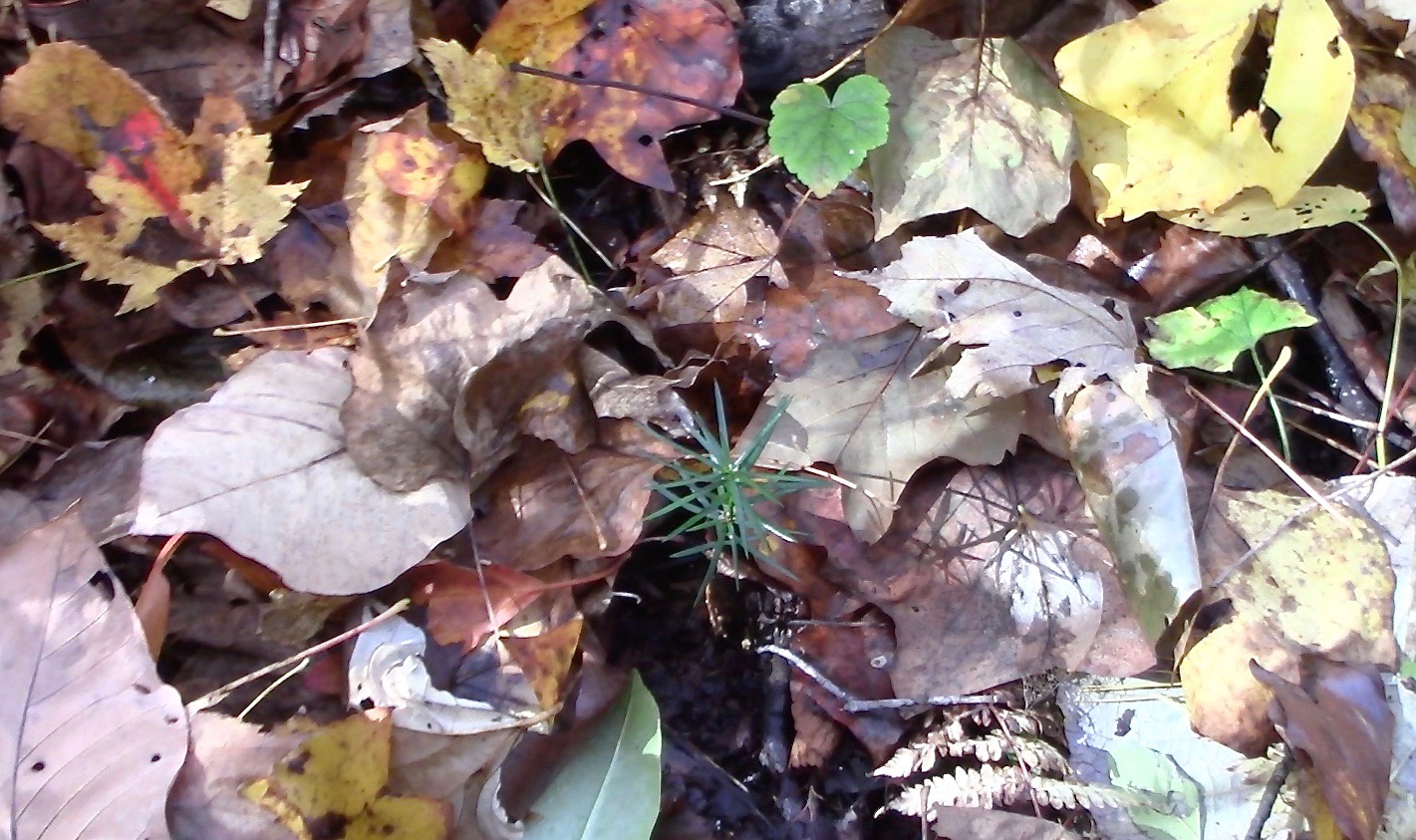
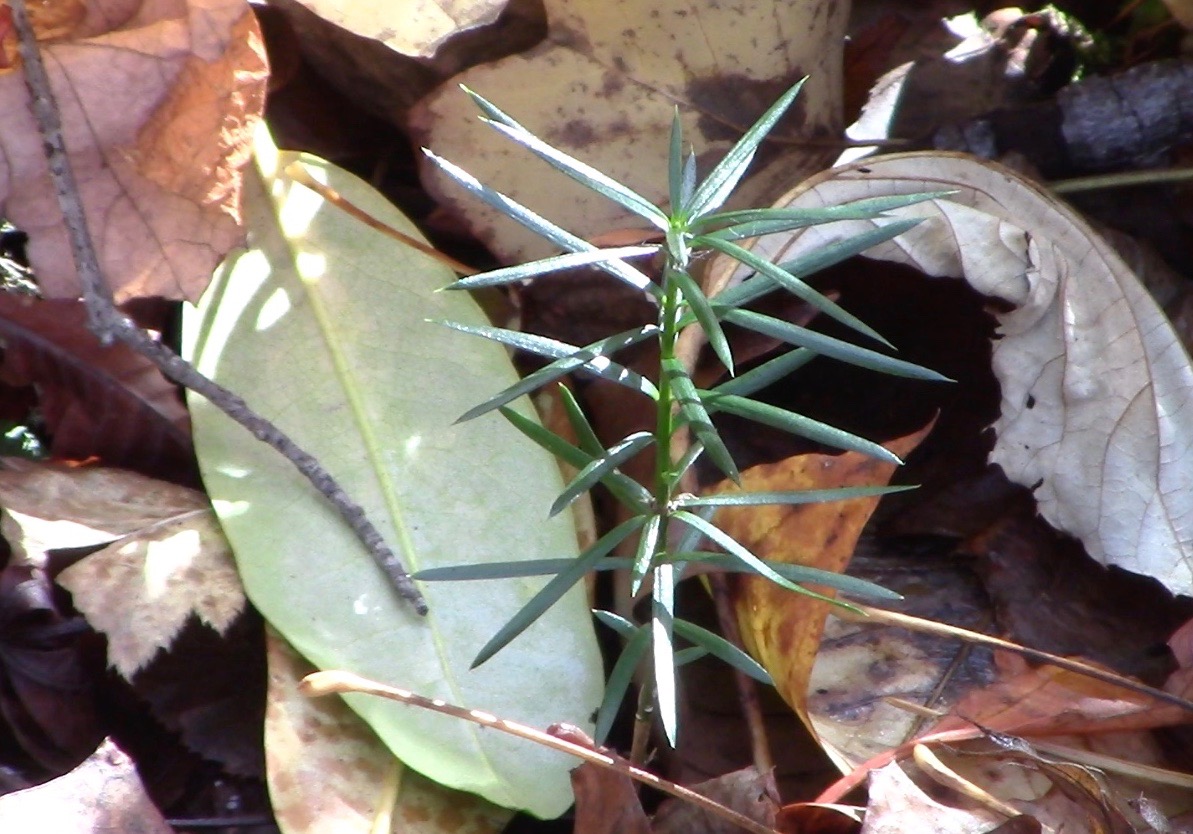
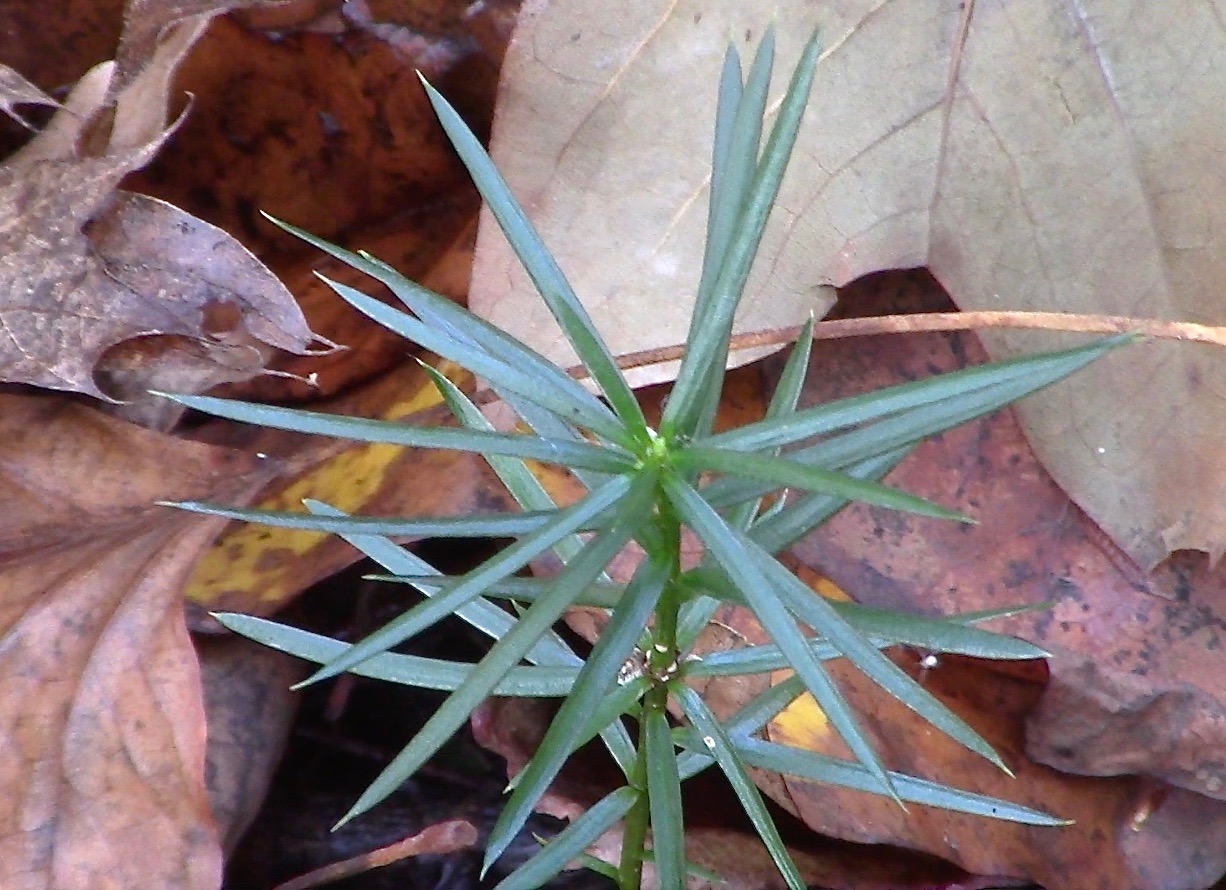

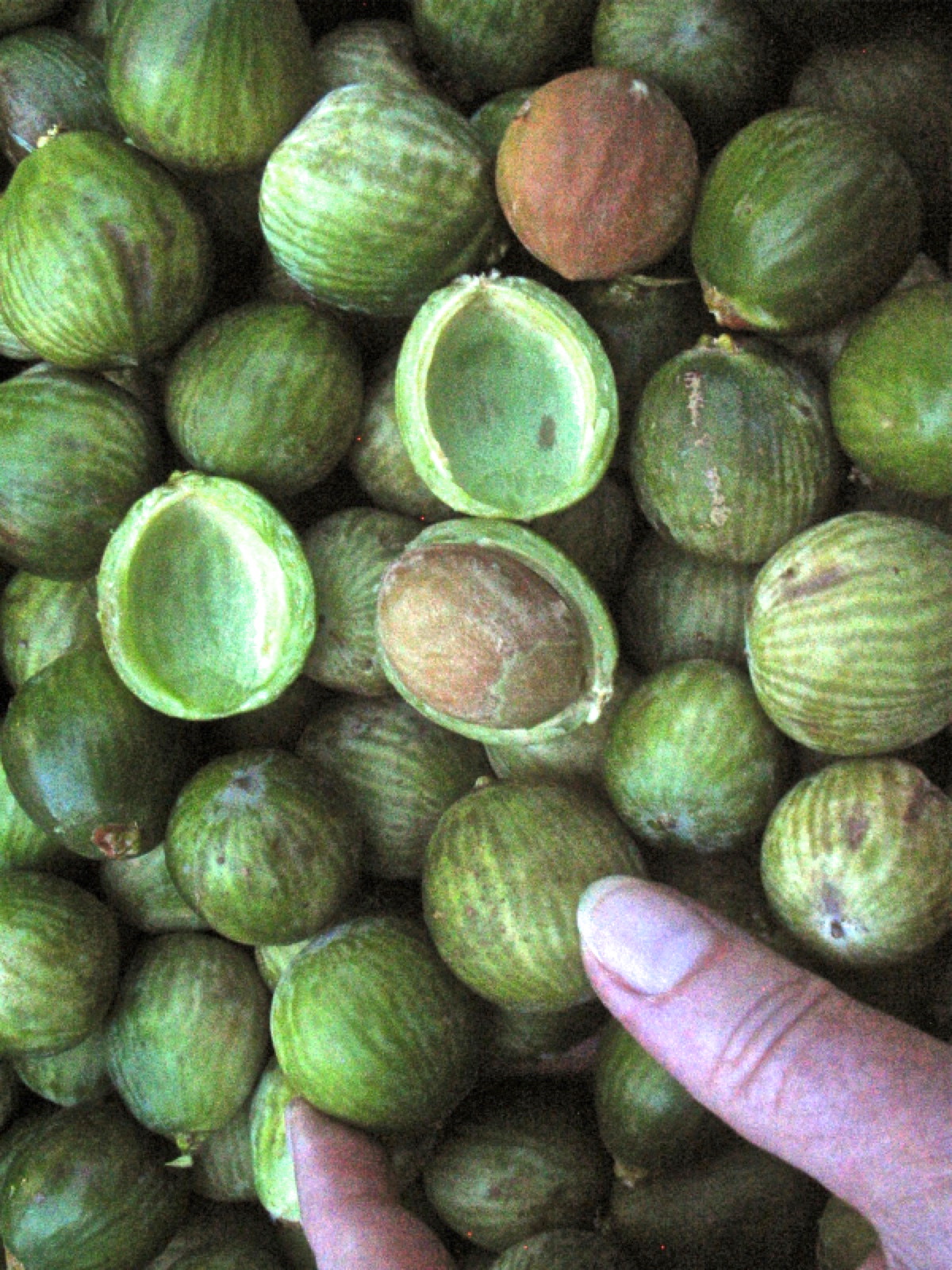
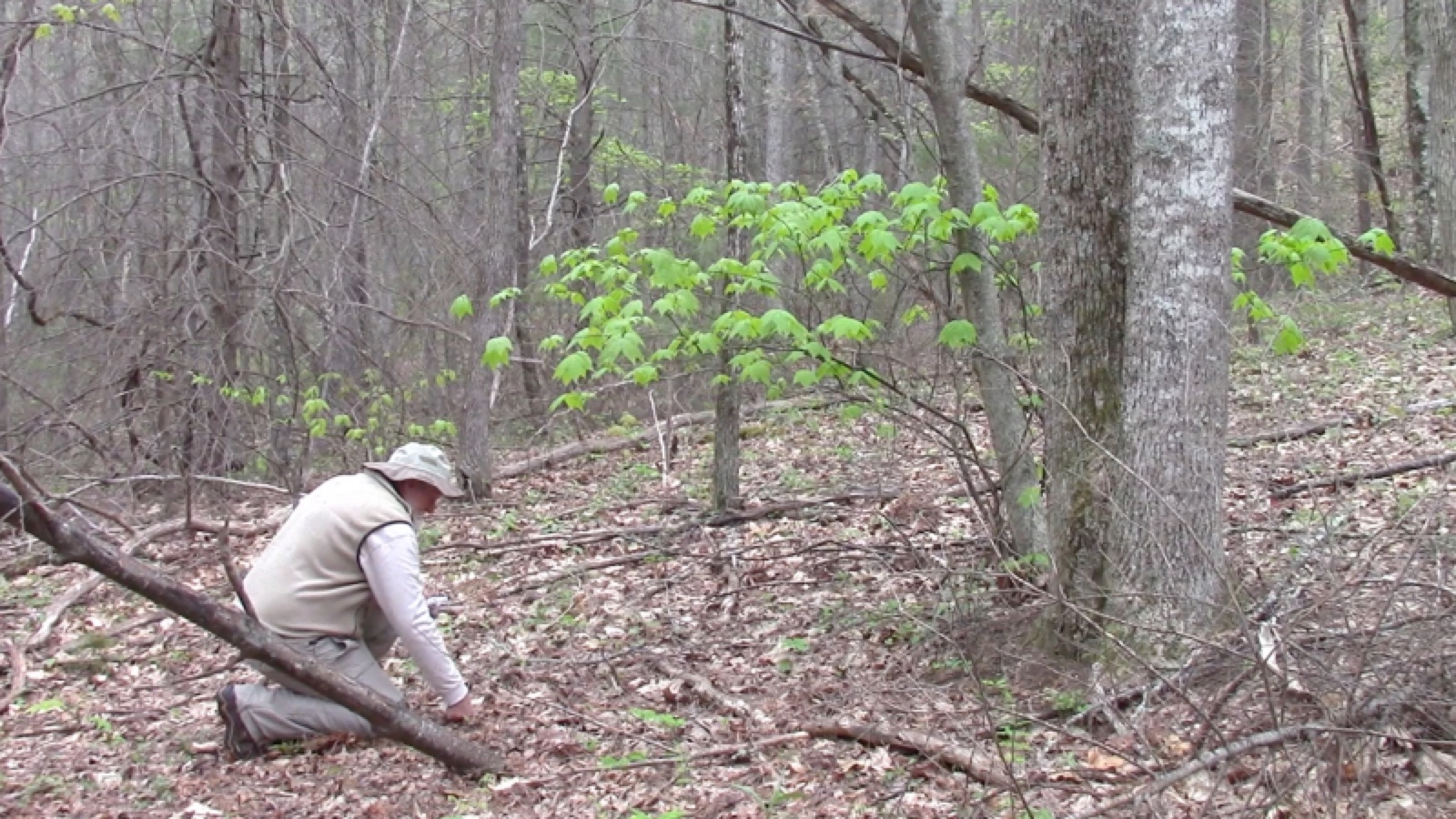
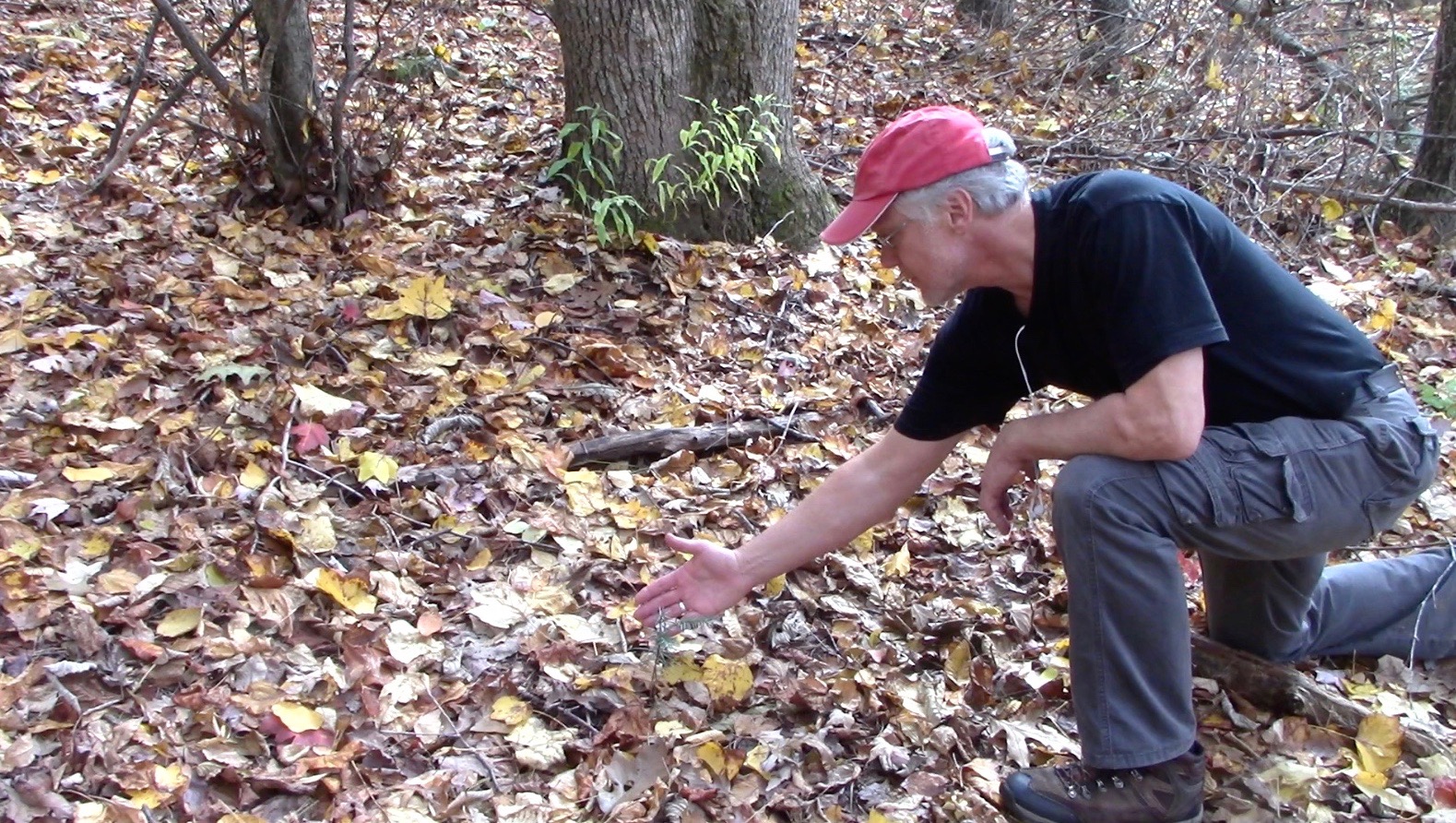
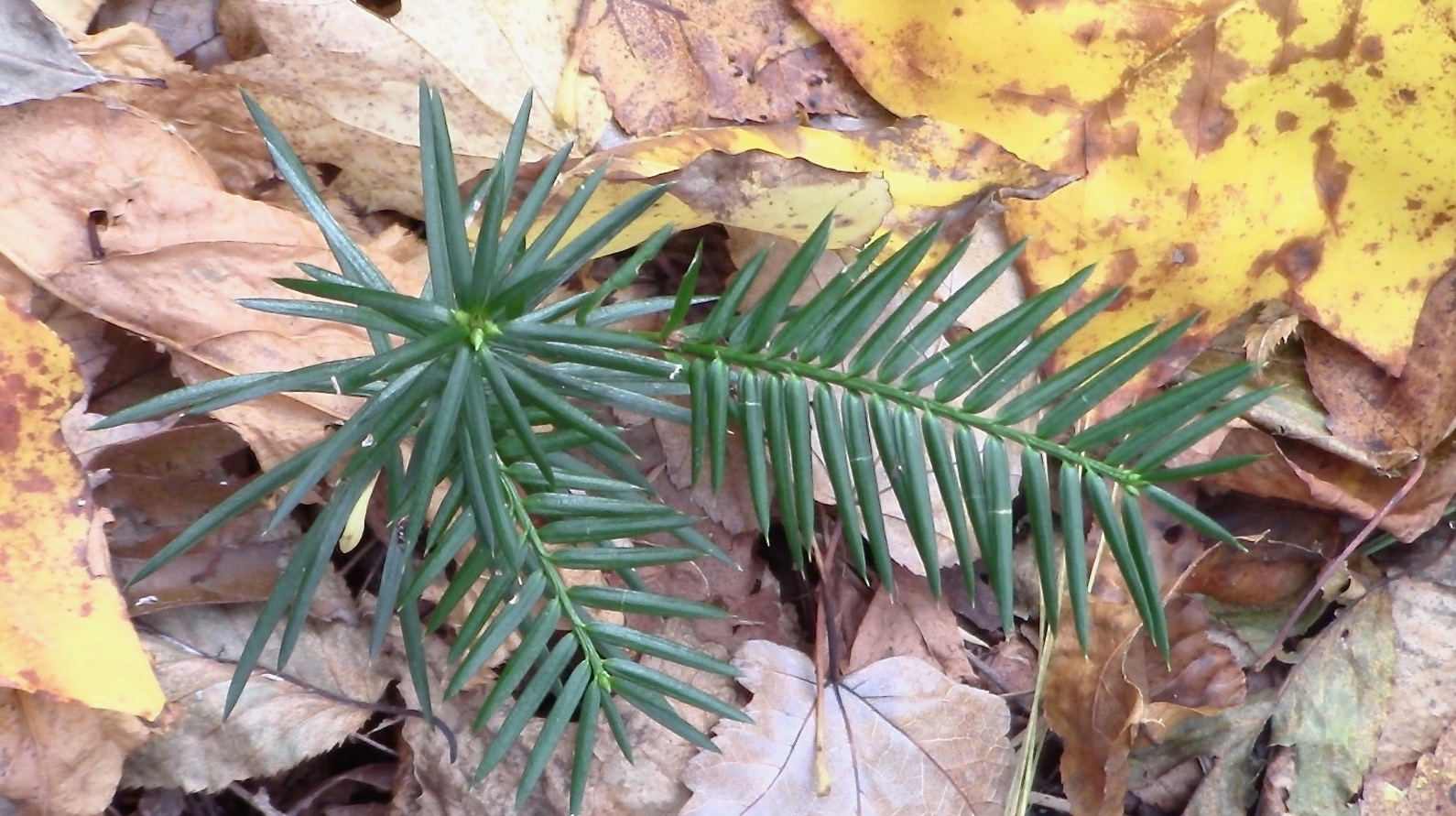
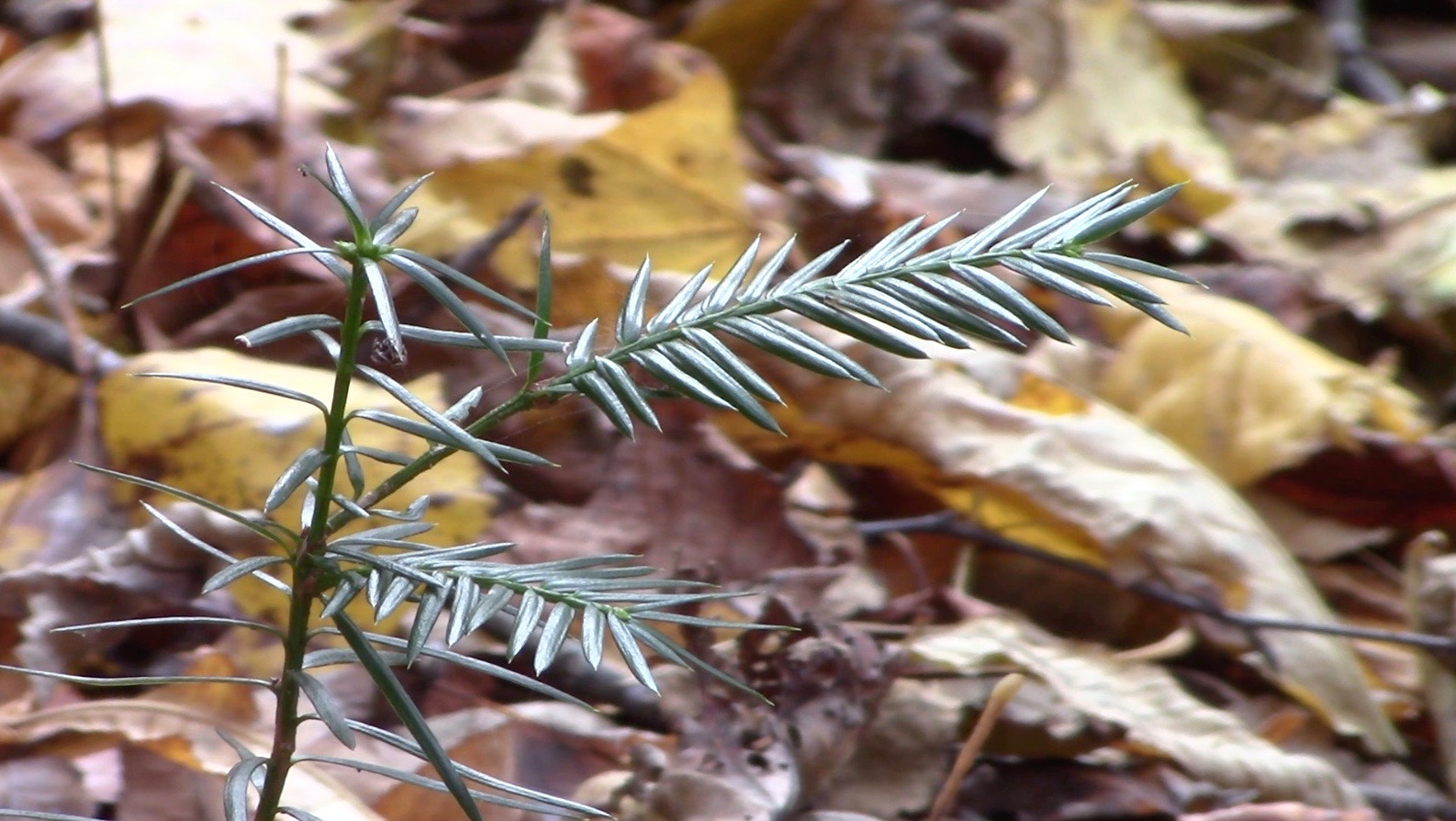
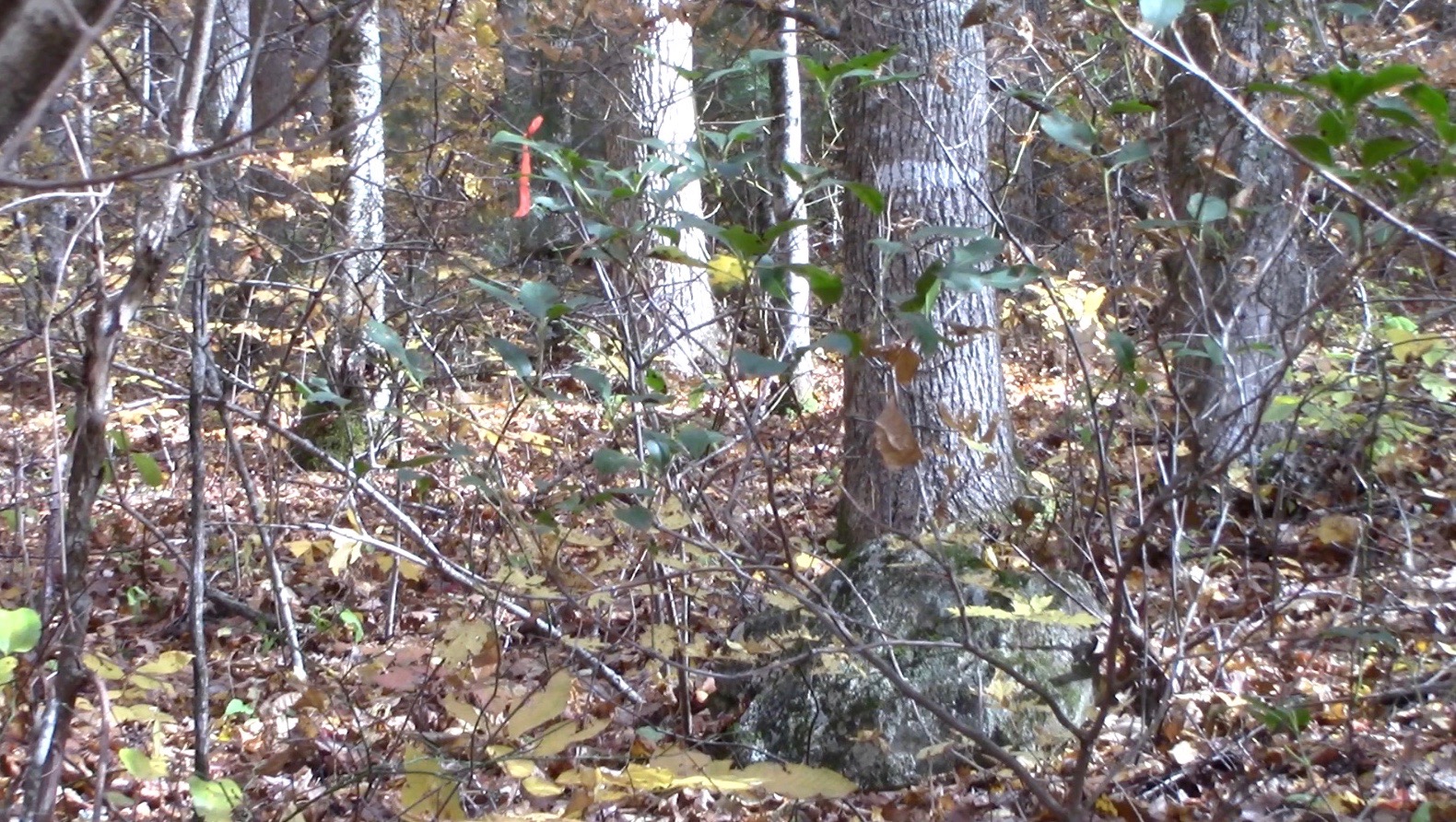
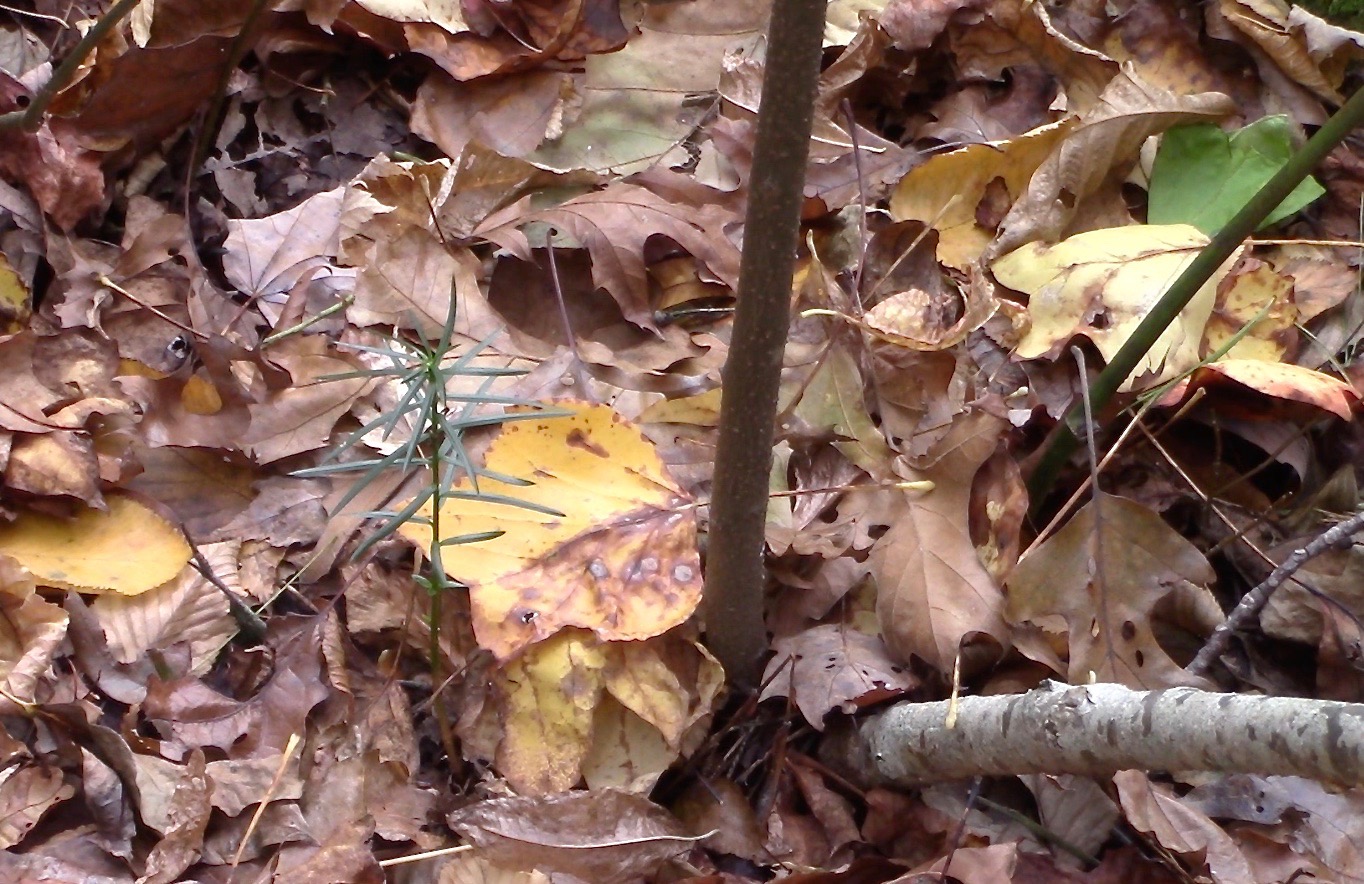
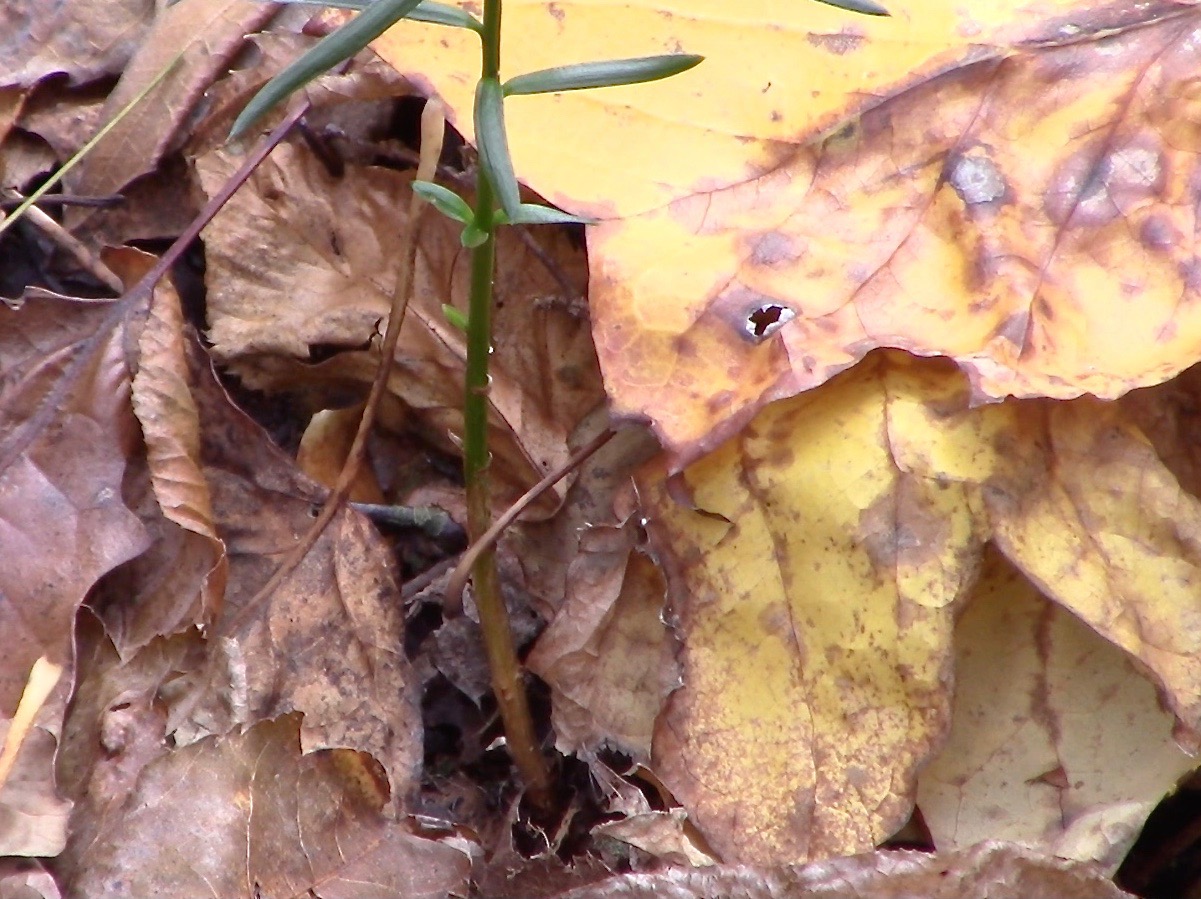
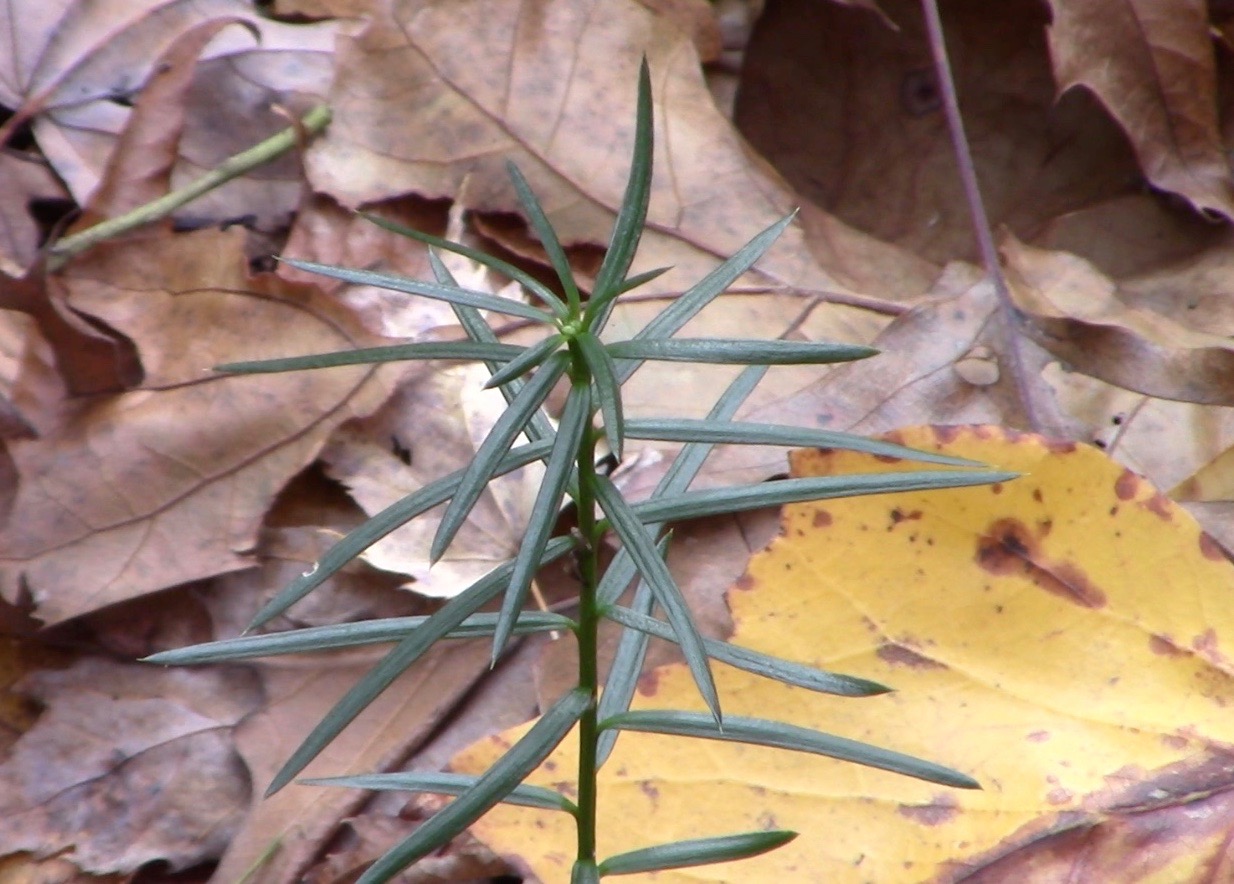
SEEDLING 4: All surrounding photos indicate a single growth spurt, vertically. As with Seedling 2, there is a tuft of shorter (less developed) leaves at the apex. 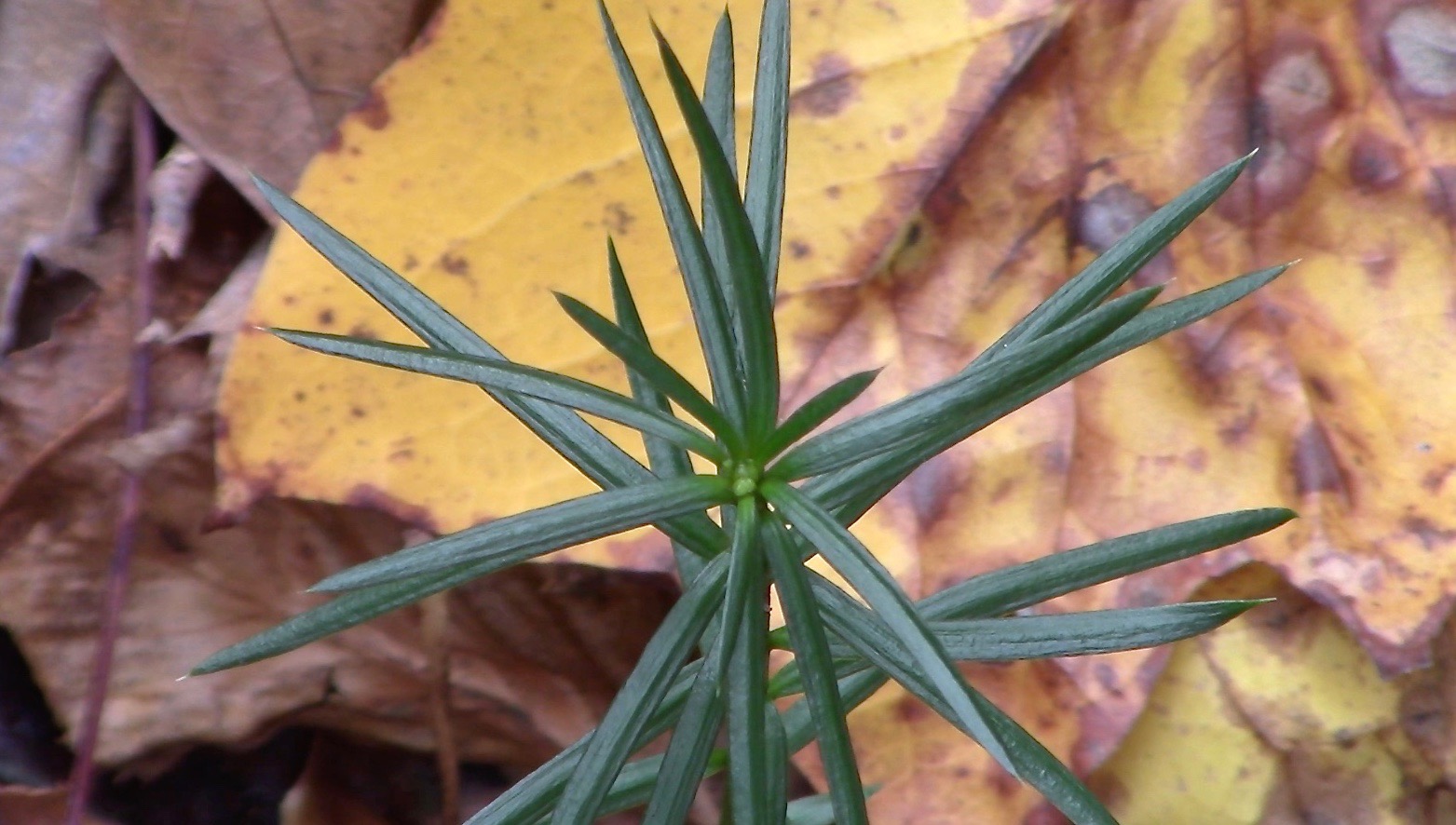
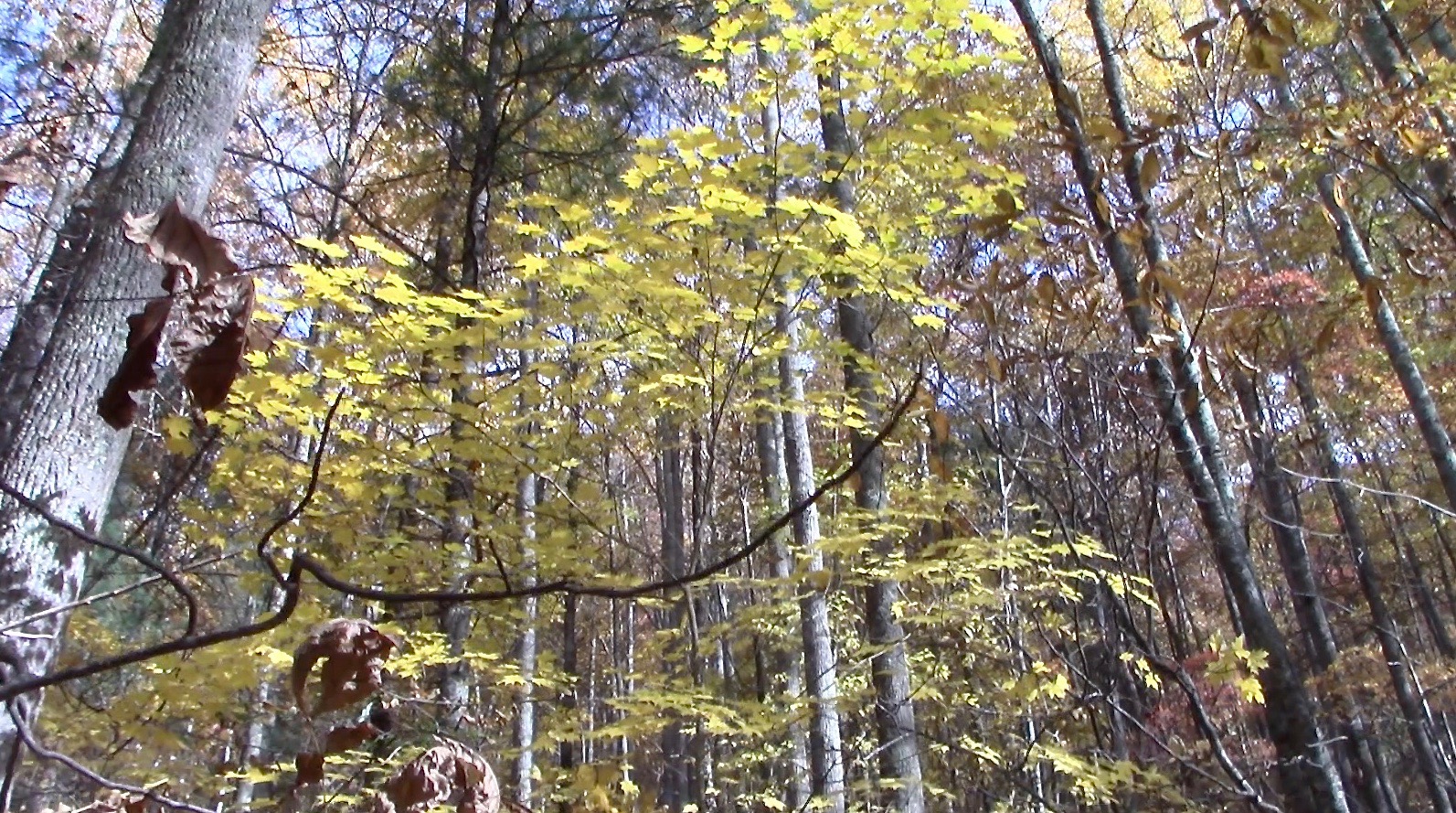
Well, that "baby maple" had grown tall 4 summers later! Luckily, it was still bearing its autumn-yellow leaves.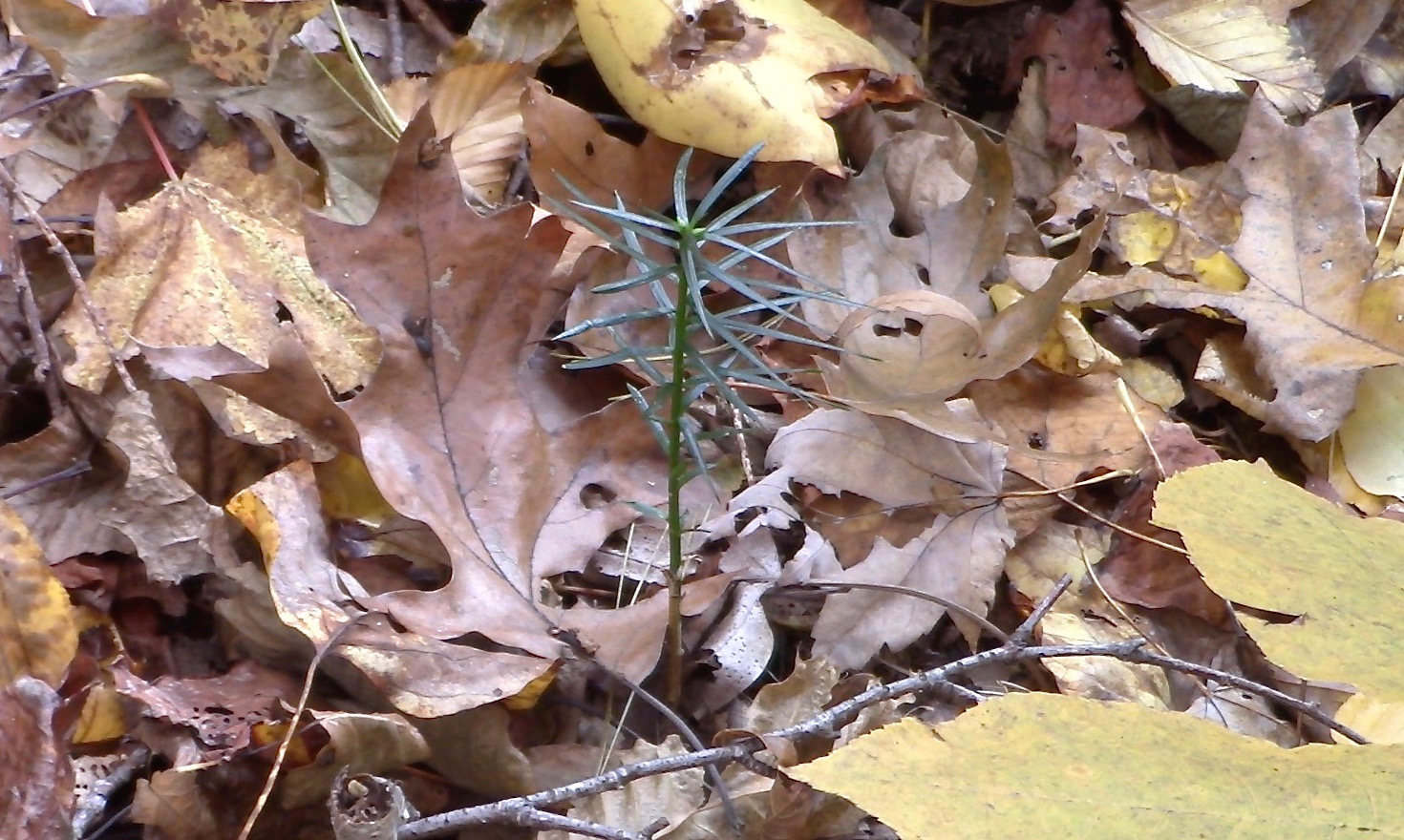
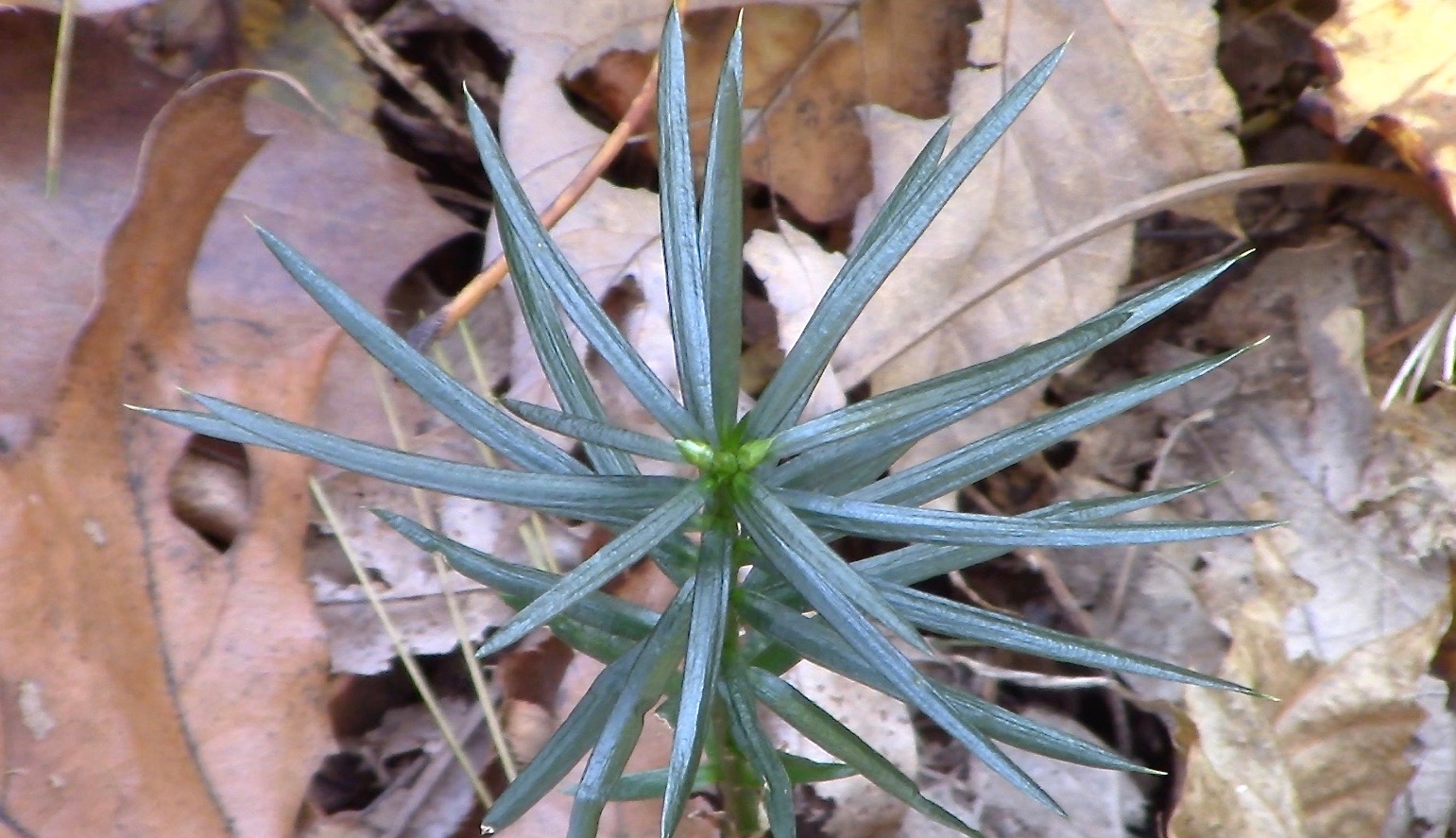
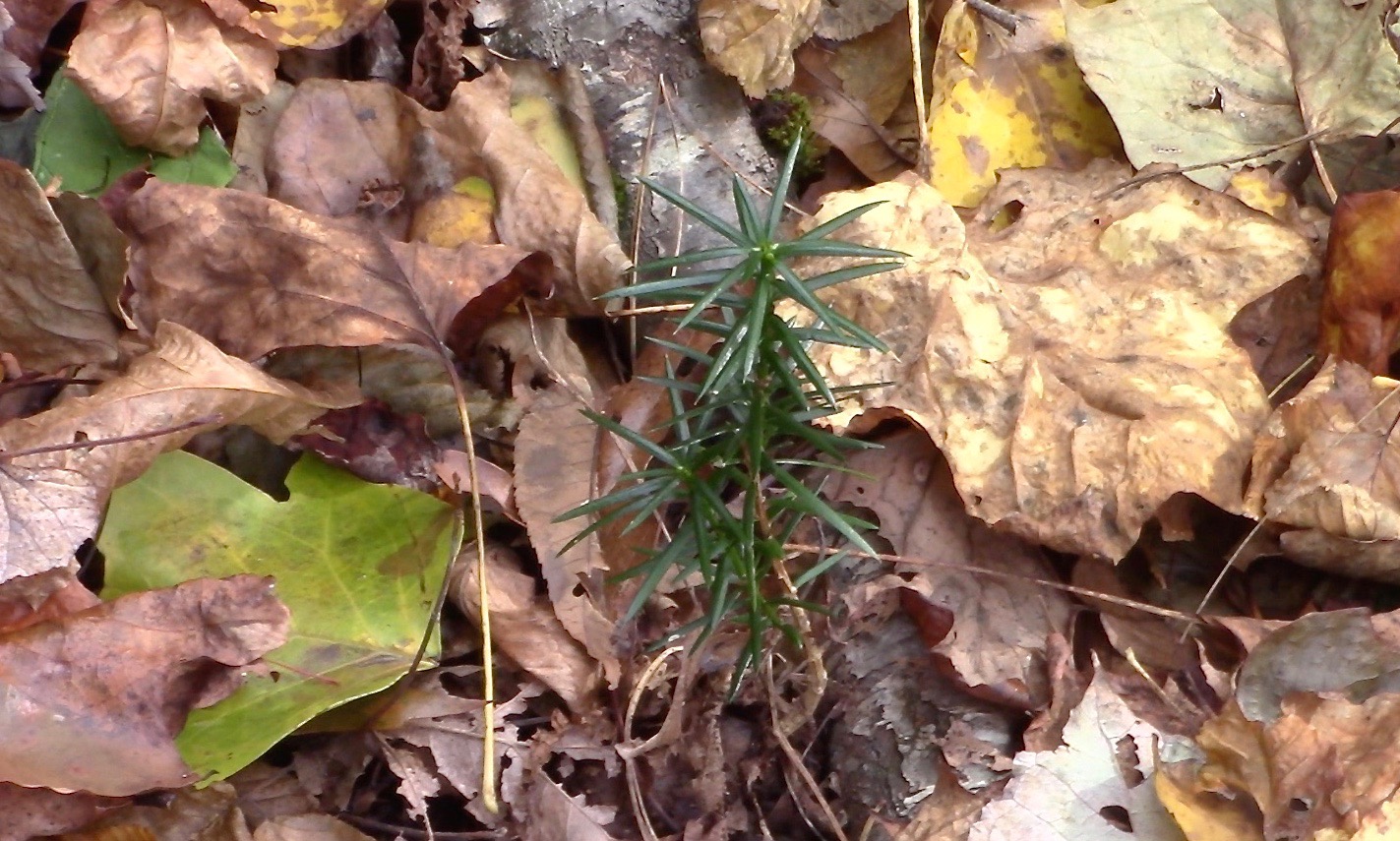
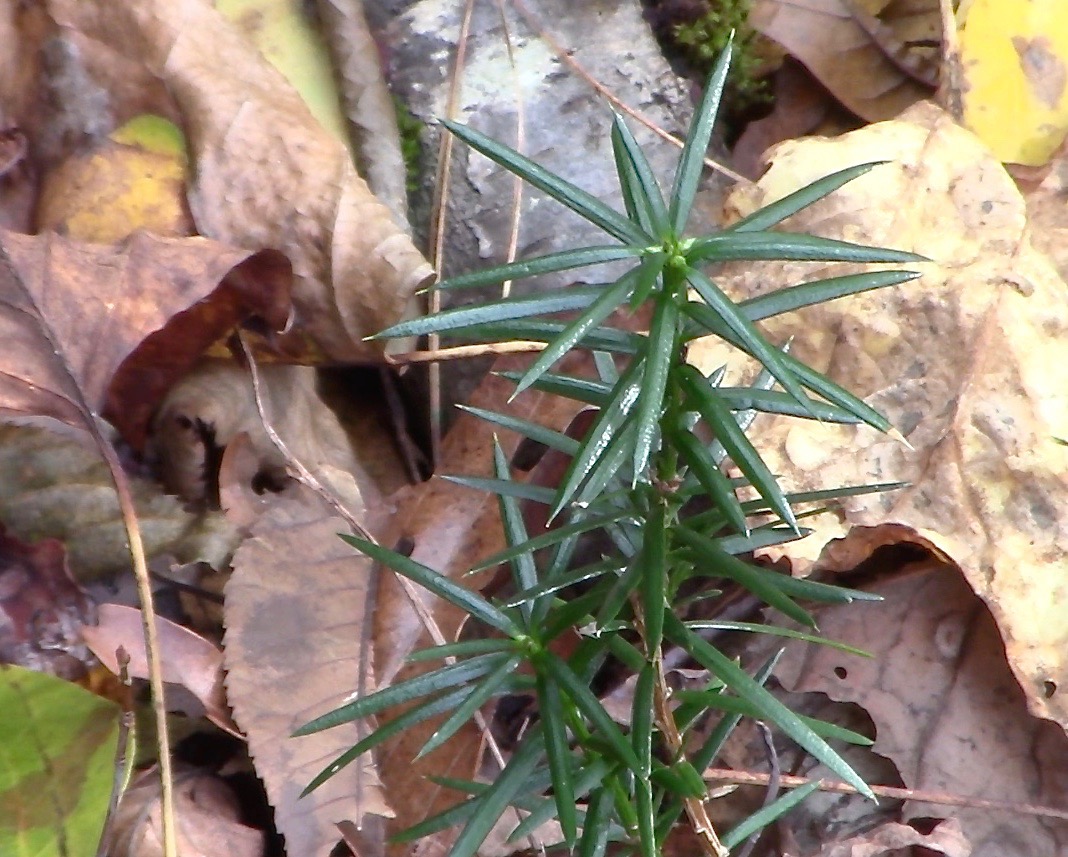
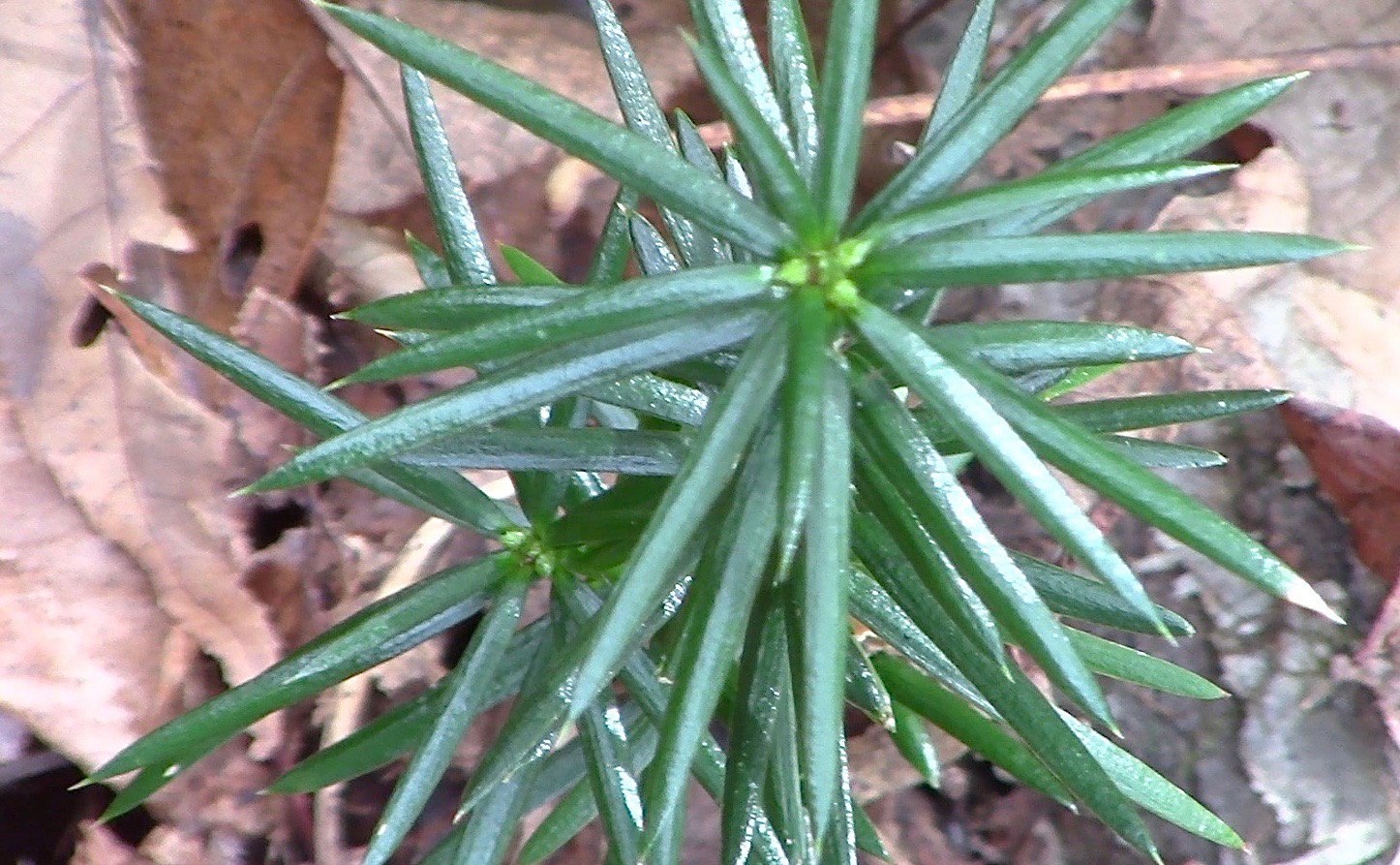
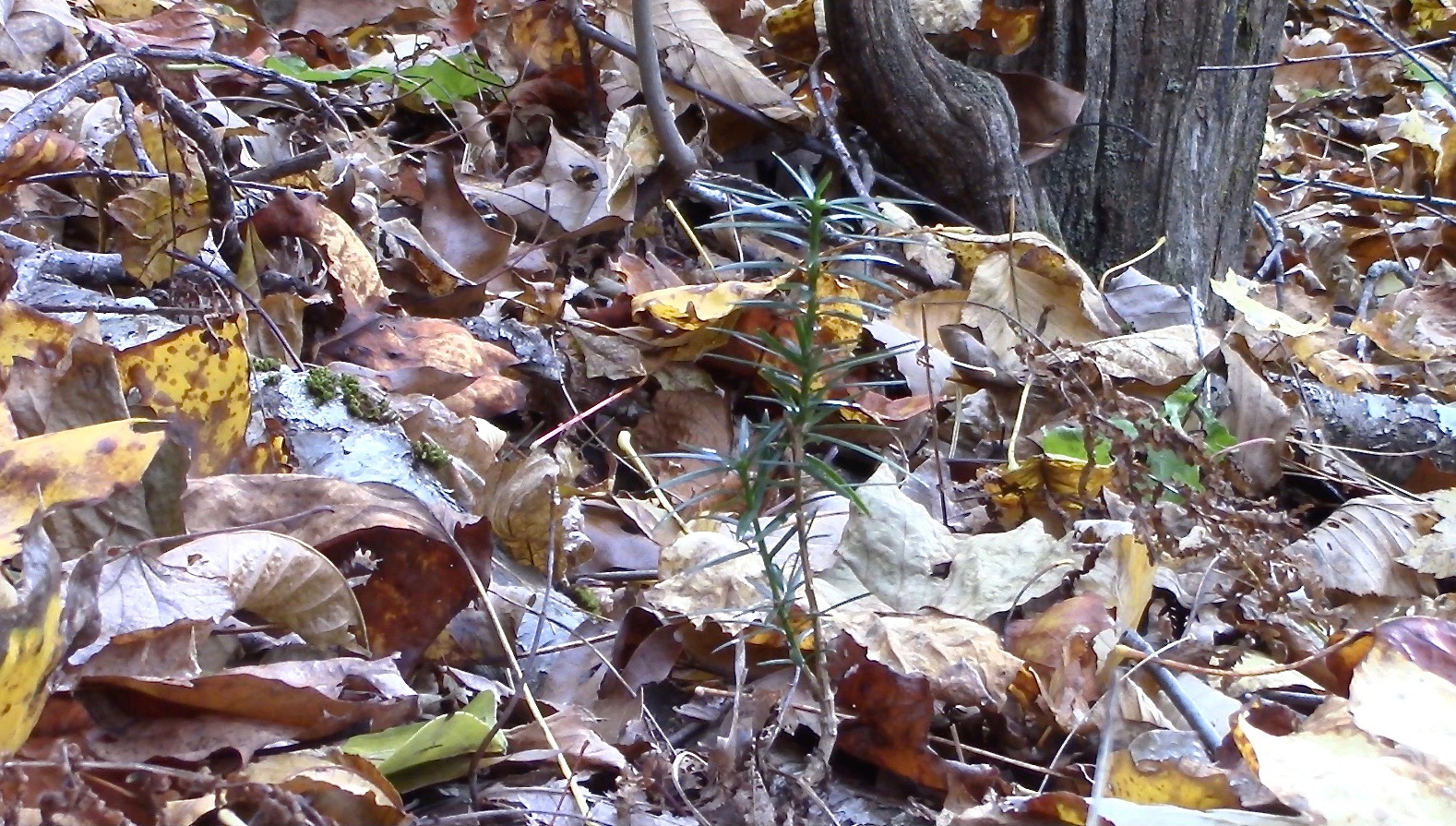
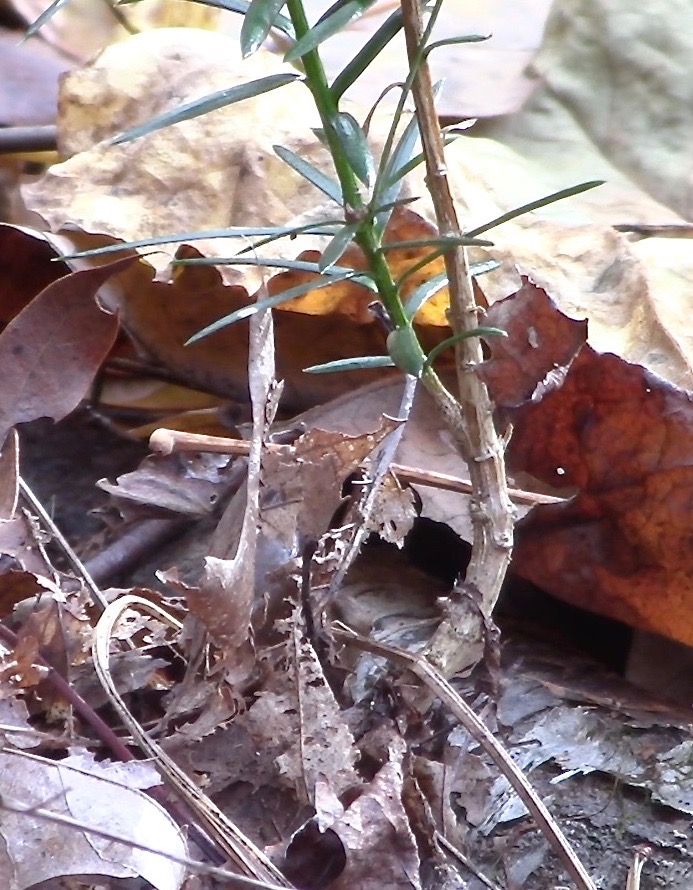
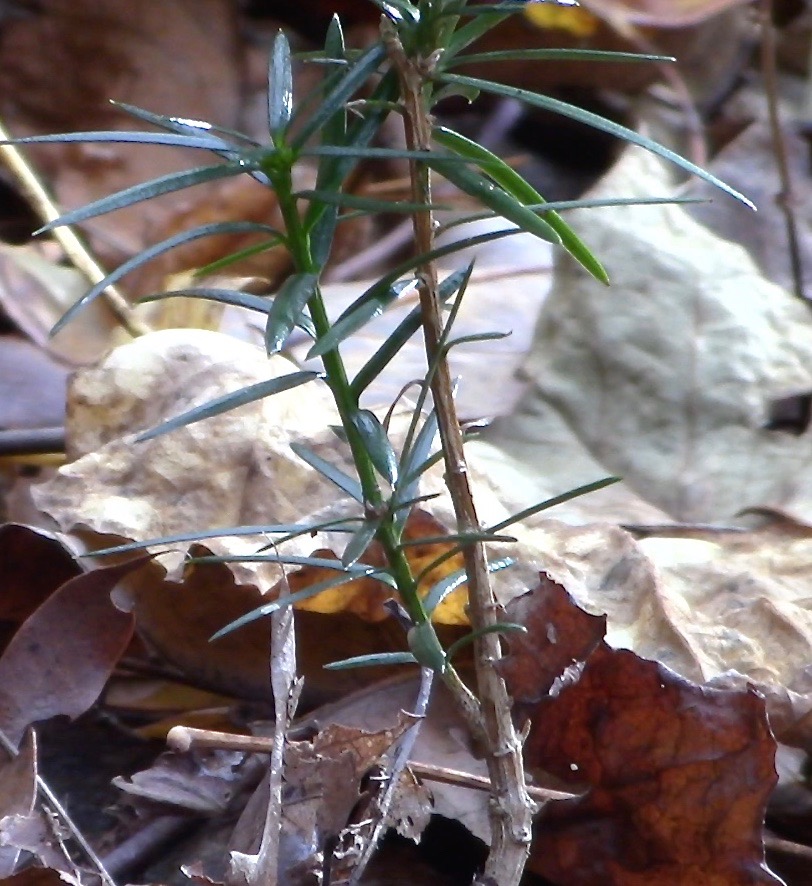
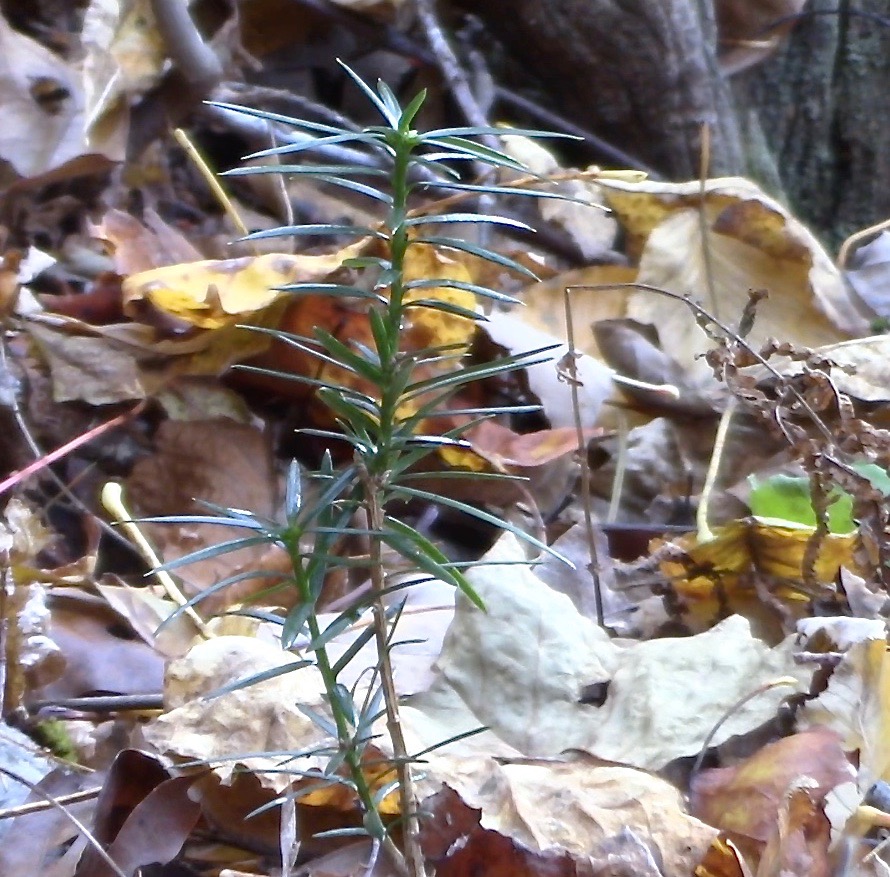
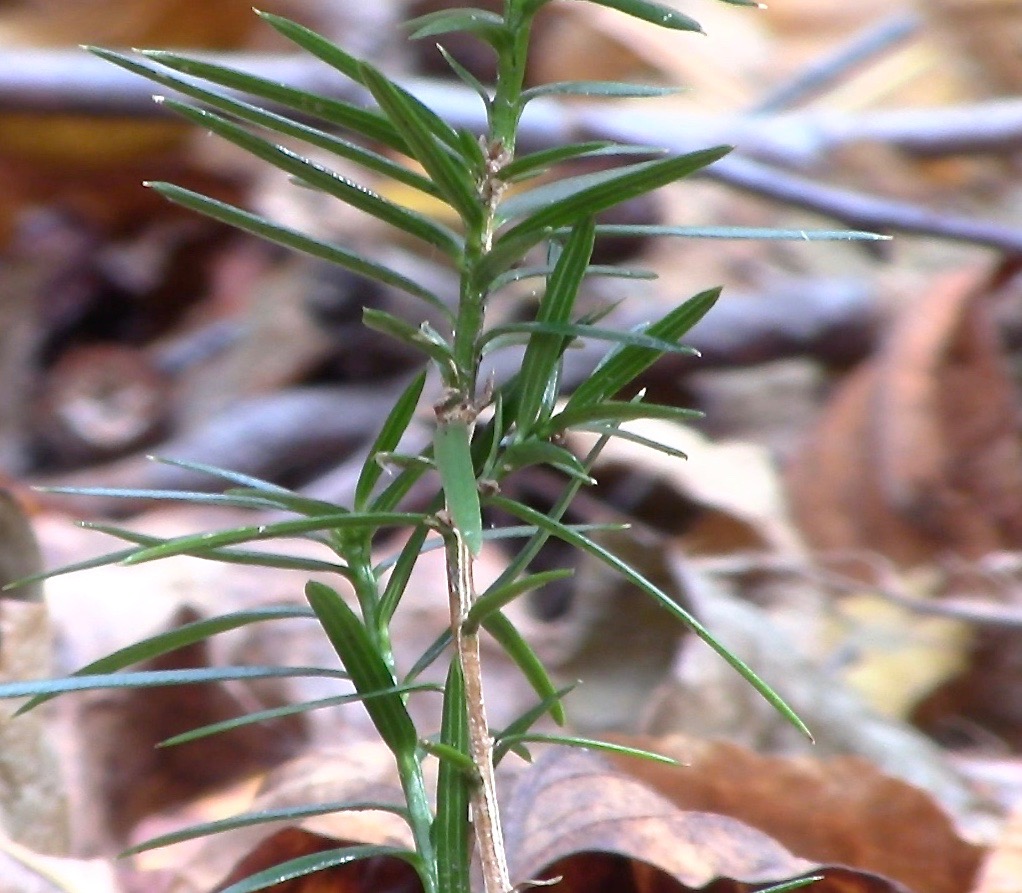
The close-up photo of the midsection of SEEDLING 6 reveals another supplementary growth just below the main stem injury, but this one angles more (toward the right) and is very short. It seems midway between the form of a vertical leader and a lateral branch.
Look carefully at the top of the photo: Did that post-injury new stem get cropped again, just an inch or so above where it started? (Notice the brown at that spot.) If so, the green above that spot would signify yet a third leader attempt (a better camera angle would answer that). Might the second injury have prompted the strange tuft of short angled growth on the right? And was it the first or the second herbivore nibbling that prompted the basal to sprout? Overall, could there be as many as 5 growth spurts over this seedling's life span?
Finally, reflect on the fact that, despite all this growth, SEEDLING 6 has not yet had a chance to put its growth into lateral branching. This in itself suggests 2 seasons of vegetative injuries. What a survivor! And could it have survived at all had it not been this close to forest-edge enhanced sunlight?
